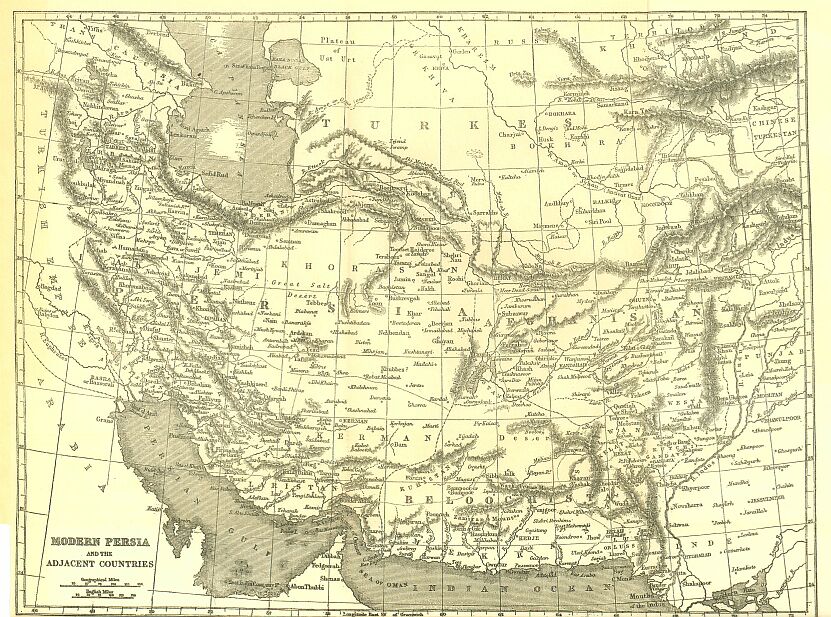
| CHAPTER IV. | LANGUAGE AND WRITING. |
| CHAPTER V. | ARCHITECTURE AND OTHER ARTS. |
| CHAPTER VI. | RELIGION. |
|
|
|

It has been intimated in the account of the Median Empire which was given in a former-volume that the language of the Persians, which was identical, or almost identical, with that of the Medes, belonged to the form of speech known to moderns as Indo-European. The characteristics of that form of speech are a certain number of common, or at least widely spread, roots, a peculiar mode of inflecting, together with a resemblance in the inflections, and a similarity of syntax or construction. Of the old Persian language the known roots are, almost without exception, kindred forms to roots already familiar to the philologist through the Sanscrit, or the Zend, or both; while many are of that more general type of which we have spoken—forms common to all, or most of the varieties of the Indo-European stock. To instance in a few very frequently recurring words—"father" is in old Persian (as in Sanscrit) pitar, which differs only in the vocalization from the Zendic patar, the Greek [ ], and the Latin pater, and of which cognate forms are the Gothic fadar, the German voter, the English father, and the Erse athair.
[See the html version for the following pages of this
chapter which is a section with hundreds of Greek
words.]
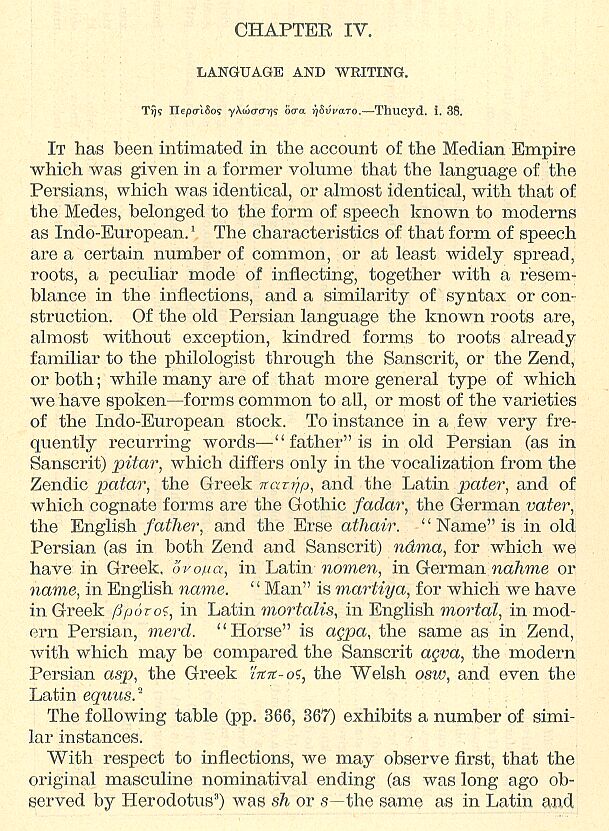
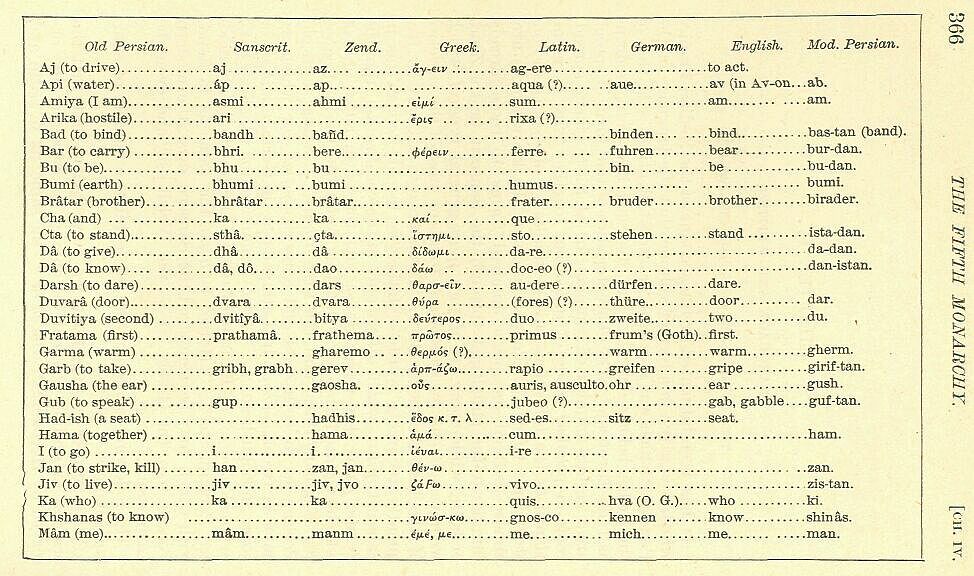
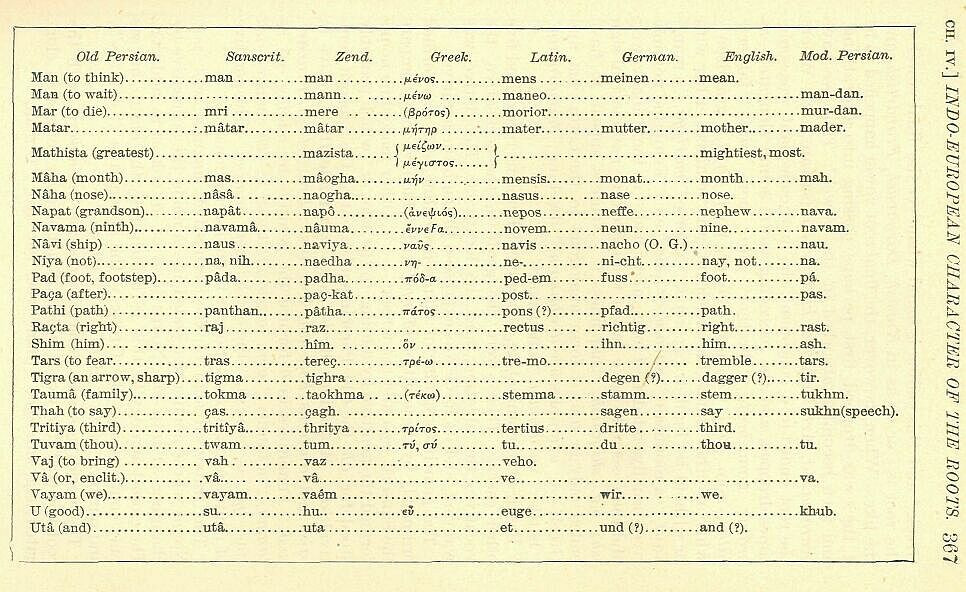
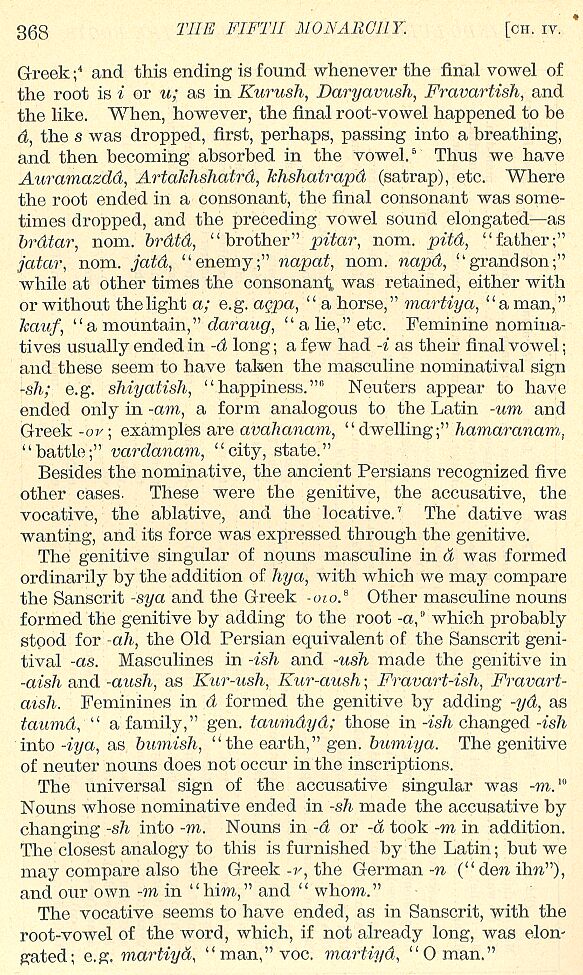
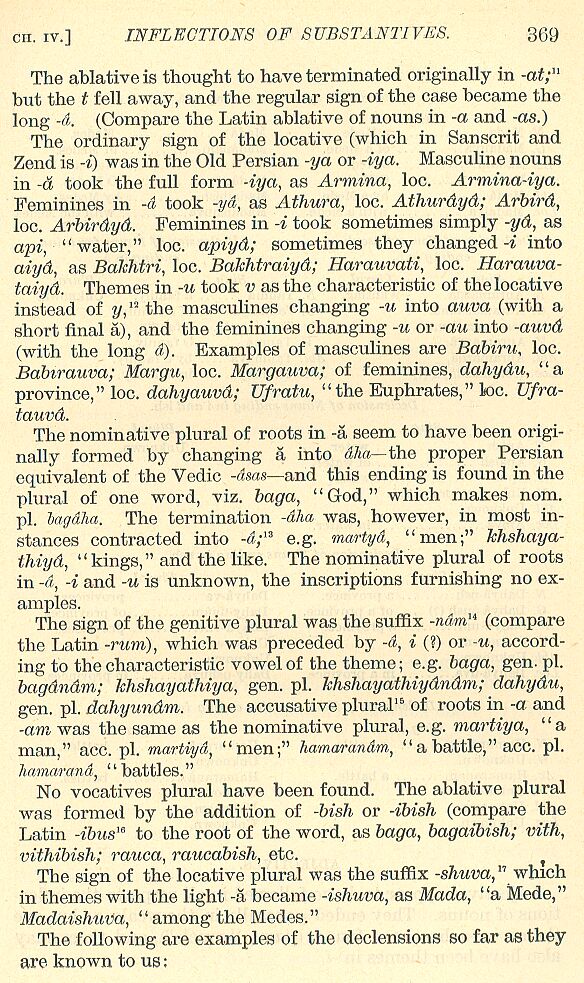
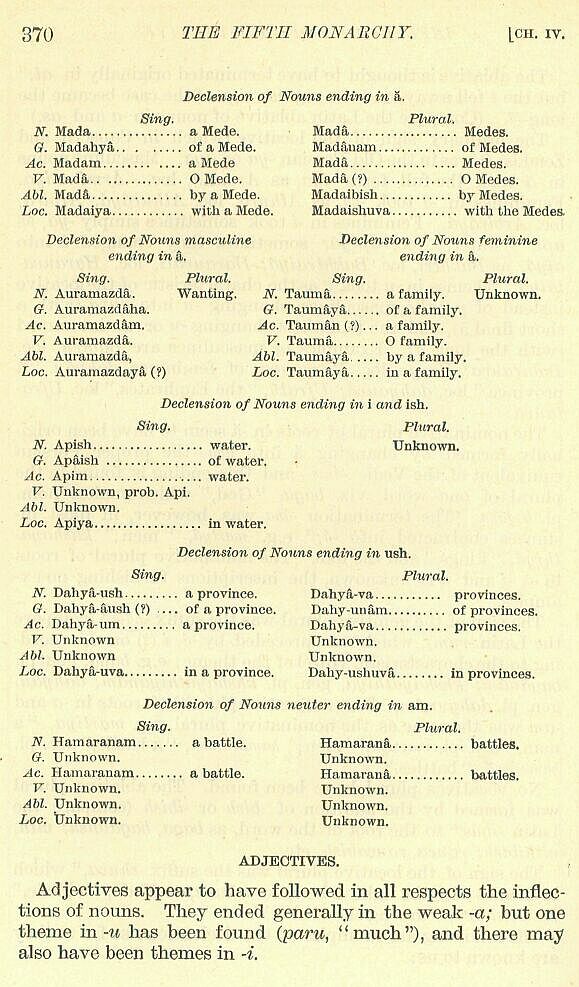
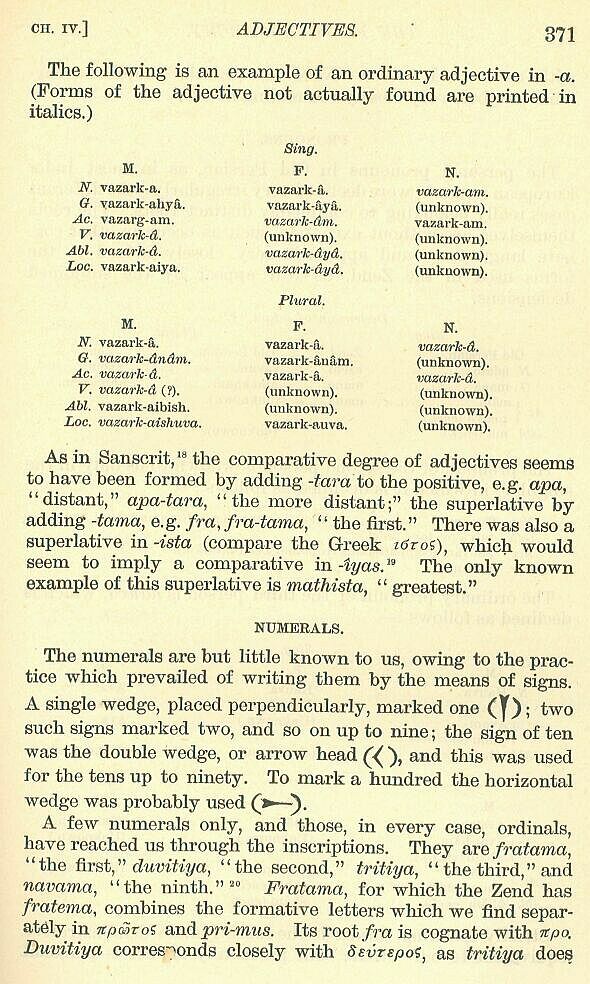
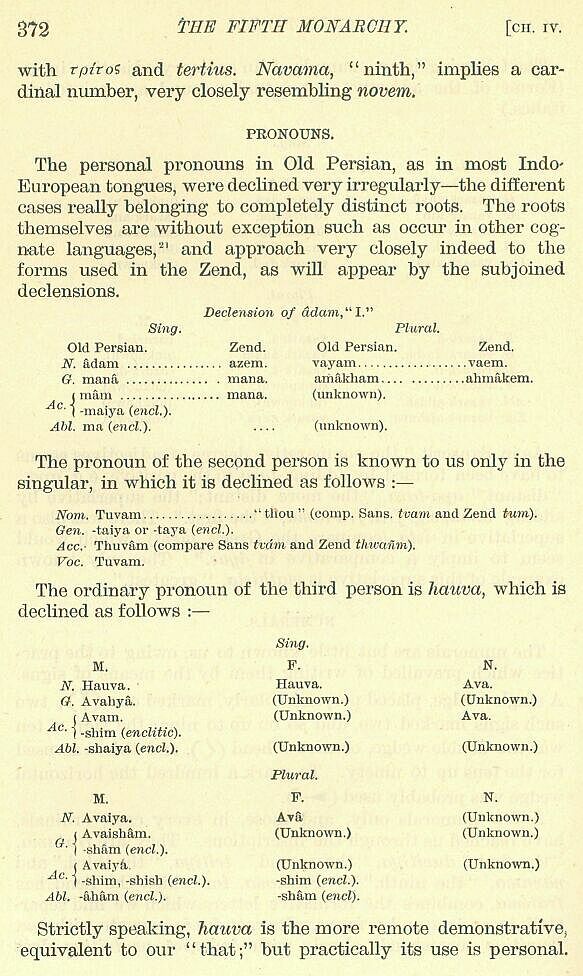
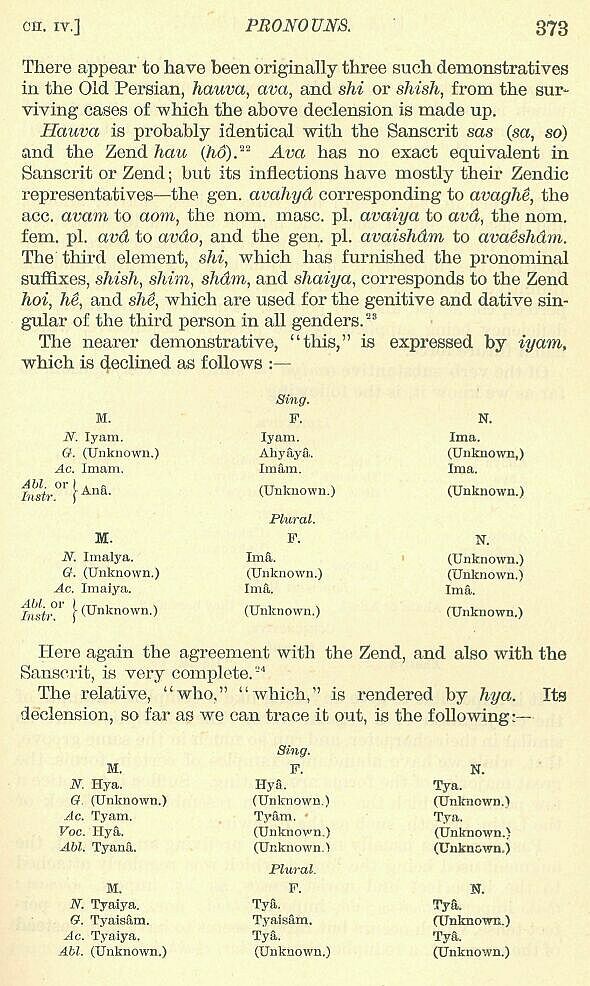
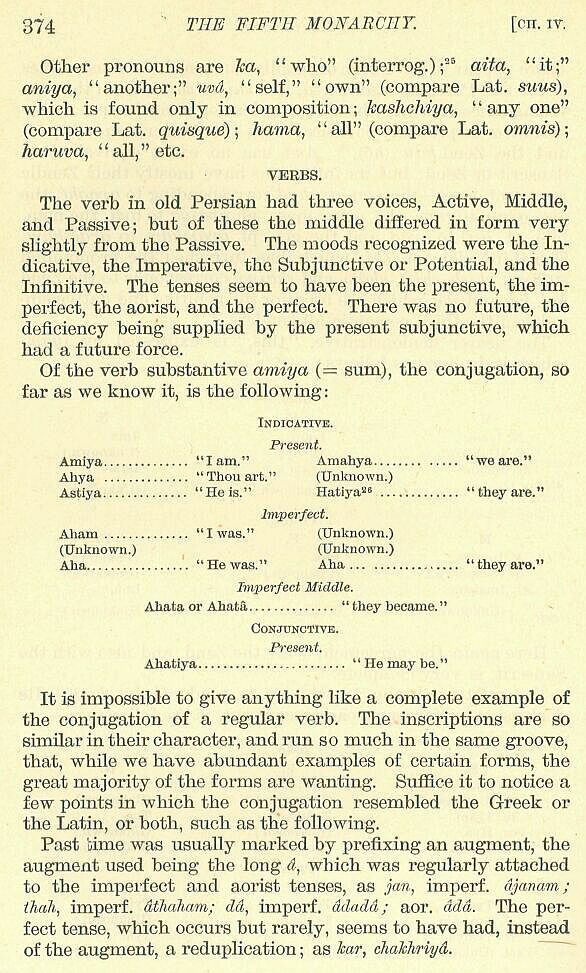
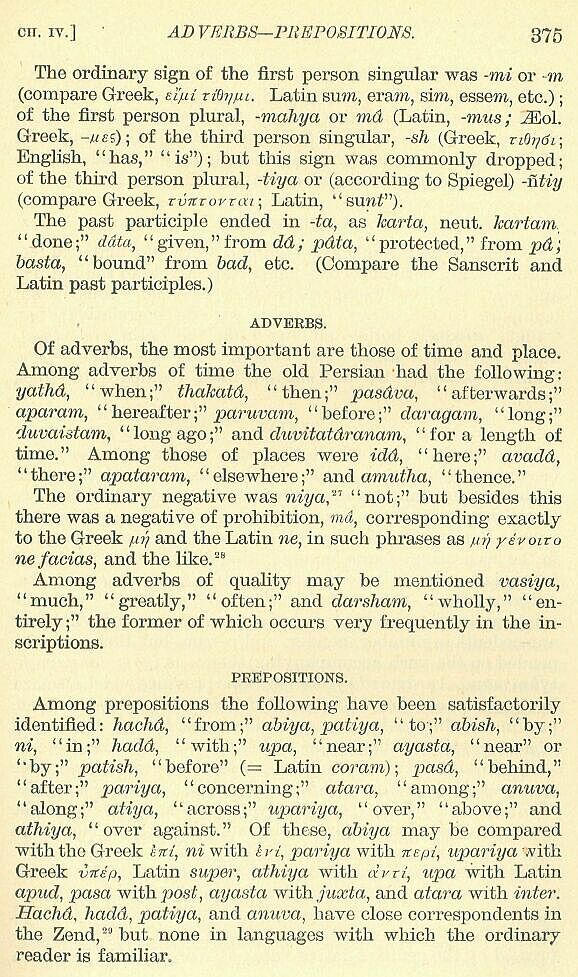
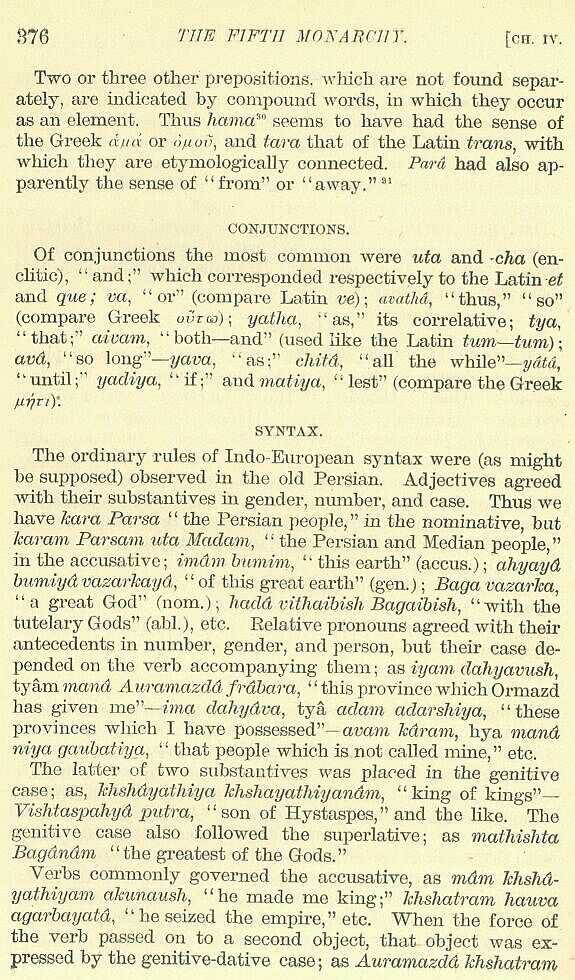
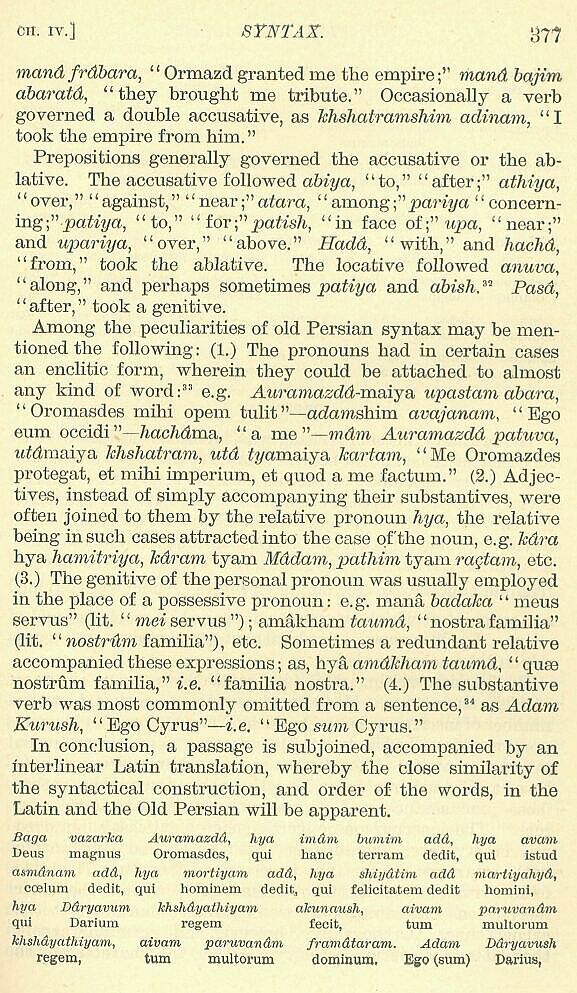
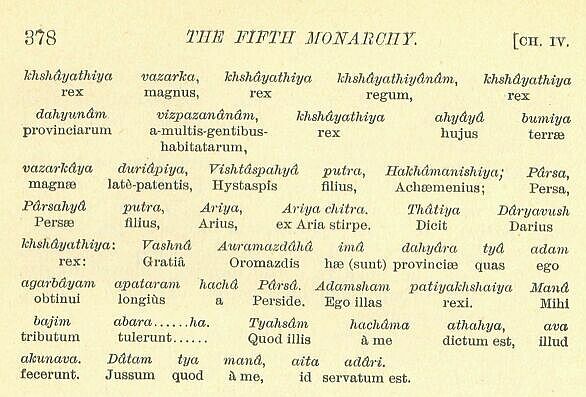
The ordinary Persian writing was identical with that which has been described in the second volume of this work as Median. A cuneiform alphabet, consisting of some thirty-six or thirty-seven forms, expressive of twenty-three distinct sounds, sufficed for the wants of the people, whose language was simple and devoid of phonetic luxuriance. Writing was from left to right, as with the Arian nations generally. Words were separated from one another by an oblique wedge; and were divided at any point at which the writer happened to reach the end of a line. Enclitics were joined without any break to the words which they accompanied.
The Persian writing which has come down to us is almost entirely upon stone. It comprises various rock tablets, a number of inscriptions upon buildings, and a few short legends upon vases and cylinders. It is in every case incised or cut into the material. The letters are of various sizes, some (as those at Elwend) reaching a length of about two inches, others (those, for instance, on the vases) not exceeding the sixth of an inch. The inscriptions cover a space of at least a hundred and eighty years, commencing with Cyrus, and terminating with Artaxerxes Ochus, the successor of Mnemon. The style of the writing is, on the whole, remarkably uniform, the latter inscriptions containing only two characters unknown to the earlier times. Orthography, however, and grammar are in these later inscriptions greatly changed, the character of the changes being indicative of corruption and decline, unless, indeed, we are to ascribe them to mere ignorance on the part of the engravers.
There can be little doubt that, besides the cuneiform character, which was only suited for inscriptions, the Persians employed a cursive writing for common literary purposes. Ctesias informs us that the royal archives were written on parchment; and there is abundant evidence that writing was an art perfectly familiar to the educated Persian. It might have been supposed that the Pehlevi, as the lineal descendant of the Old Persian language, would have furnished valuable assistance towards solving the question of what character the Persians employed commonly; but the alphabetic type of the Pehlevi inscriptions is evidently Semitic; and it would thus seem that the old national modes of writing had been completely lost before the establishment by Ardeshir, son of Babek, of the new Persian Empire.

If in the old world the fame of the Persians, as builders and artists, fell on the whole below that of the Assyrians and Babylonians—their instructors in art, no less than in letters and science—it was not so much that they had not produced works worthy of comparison with those which adorned Babylon and Nineveh, as that, boasting less antiquity and less originality than those primitive races, they did not strike in the same way the imagination of the lively Greeks, who moreover could not but feel a certain jealousy of artistic successes, which had rewarded the efforts of a living and rival people. It happened, moreover, that the Persian masterpieces were less accessible to the Greeks than the Babylonian, and hence there was actually less knowledge of their real character in the time when Greek literature was at its best. Herodotus and Xenophon, who impressed on their countrymen true ideas of the grandeur and magnificence of the Mesopotamian structures, never penetrated to Persia Proper, and perhaps never beheld a real Persian building. Ctesias, it is true, as a resident at the Achaemenian Court for seventeen years, must certainly have seen Susa and Ecbatana, if not even Persepolis, and he therefore must have been well acquainted with the character of Persian palaces; but, so far as appears from the fragments of his work which have come down to us, he said but little on the subject of these edifices. It was not until Alexander led his cohorts across the chain of Zagros to the high plateau beyond, that a proper estimate of the great Persian buildings could be made; and then the most magnificent of them all was scarcely seen before it was laid in ruins. The barbarous act of the great Macedonian conqueror, in committing the palace of Persepolis to the flames, tended to prevent a full recognition of the real greatness of Persian art even after the Greeks had occupied the country; but we find from this time a certain amount of acknowledgment of its merits—a certain number of passages, which, like that which forms the heading to this chapter, admit alike its grandeur and its magnificence.
If, however, the ancients did less than justice to the efforts of the Persians in architecture, sculpture, and the kindred arts, moderns have, on the contrary, given them rather an undue prominence. From the middle of the seventeenth century, when Europeans first began freely to penetrate the East, the Persian ruins, especially those of Persepolis, drew the marked attention of travellers; and in times when the site of Babylon had attracted but scanty notice, and that of Nineveh and the other great Assyrian cities was almost unknown, English, French, and German savans measured, described, and figured the Persian remains with a copiousness and exactness that left little to desire. Chardin, the elder Mebuhr, Le Brun, Ouseley, Ker Porter, exerted themselves with the most praiseworthy zeal to represent fully and faithfully the marvels of the Chehl Minar; and these persevering efforts were followed within no very lengthy period by the splendid and exhaustive works of the Baron Texier and of MM. Flandin and Coste. Persepolis rose again from its ashes in the superb and costly volumes of these latter writers, who represented on the grandest scale, and in the most finished way, not only the actual but the ideal—not only the present but the past—placing before our eyes at once the fullest and completest views of the existing ruins, and also restorations of the ancient structures, some of them warm with color and gilding, which, though to a certain extent imaginary, probably give to a modern the best notion that it is now possible to form of an old Persian edifice.
It is impossible within the limits of the present work, and with the resources at the author's command, to attempt a complete description of the Persian remains, or to vie with writers who had at their disposal all the modern means of illustration. By the liberality of a well-known authority on architecture, he is able to present his readers with certain general views of the most important structures; and he also enjoys the advantage of illustrating some of the most curious of the details with engravings from a set of photographs recently taken. These last have, it is believed, an accuracy beyond that of any drawings hitherto made, and will give a better idea than words could possibly do of the merit of the sculptures. With these helps, and with the addition of reduced copies from some of MM. Flandin and Coste's plates, the author hopes to be able to make his account fairly intelligible, and to give his readers the opportunity of forming a tolerably correct judgment on the merit of the Persian art in comparison with that of Babylon and Assyria.
Persian architectural art displayed itself especially in two forms of building—the palace and the tomb. Temples were not perhaps unknown in Persia, though much of the worship may always have been in the open air; but temples, at least until the time of Artaxerxes Mnemon, were insignificant, and neither attracted the attention of contemporaries, nor were of such a character as to leave traces of themselves to after times. The palaces of the Persian kings, on the other hand, and the sepulchres which they prepared for themselves, are noticed by many ancient writers as objects of interest; and, notwithstanding certain doubts which have been raised in recent years, it seems tolerably certain that they are to be recognized in the two chief classes of ancient ruins which still exist in the country.
The Persian palatial buildings, of which traces remain, are four in number. One was situated at Ecbatana, the Median capital, and was a sort of adjunct to the old residence of the Median kings. Of this only a very few vestiges have been hitherto found; and we can merely say that it appears to have been of the same general character with the edifices which will be hereafter described. Another was built by Darius and his son Xerxes on the great mound of Susa; and of this we have the ground-plan, in a great measure, and various interesting details. A third stood within the walls of the city of Persepolis, but of this not much more is left than of the construction at Ecbatana. Finally, there was in the neighborhood of Persepolis, but completely distinct from the town, the Great Palace, which, as the chief residence, at any rate of the later kings, Alexander burnt, and of which the remains still to be seen are ample, constituting by far the most remarkable group of buildings now existing in this part of Asia.
It is to this last edifice, or group of edifices, that the reader's attention will be specially directed in the following pages. Here the greatest of the Persian monarchs seem to have built the greatest of their works. Here the ravages of time and barbarism, sadly injurious as they may have been, have had least effect. Here, moreover, modern research has spent its chief efforts, excavations having been made, measurements effected, and ground-plans laid down with accuracy. In describing the Persepolitan buildings we have aids which mostly fail us elsewhere—charts, plans, drawings in extraordinary abundance and often of high artistic value, elaborate descriptions, even photographs. [PLATE XXXVIII., Fig. 3.] If the describer has still a task of some difficulty to perform, it is because an overplus of material is apt to cause almost as much embarrassment as too poor and scanty a supply.
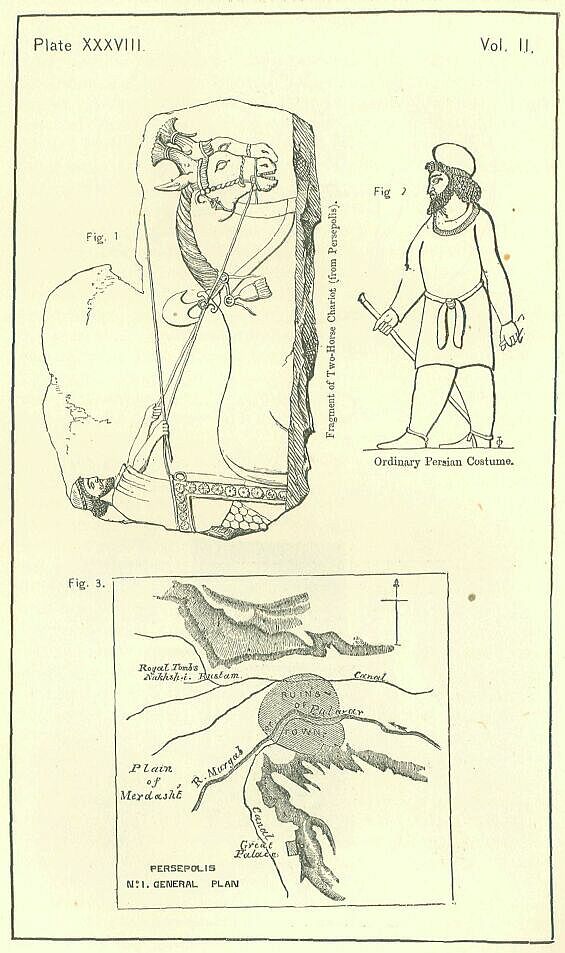
The buildings at Persepolis are placed upon a vast platform. It was the practice of the Persians, as of the Assyrians and Babylonians, to elevate their palaces in this way. They thus made them at once more striking to the eye, more dignified, and more easy to guard. In Babylonia an elevated habitation was also more healthy and more pleasant, being raised above the reach of many insects, and laid open to the winds of heaven, never too boisterous in that climate. Perhaps the Assyrians and Persians in their continued use of the custom, to some extent followed a fashion, elevating their royal residences, not so much for security or comfort, as because it had come to be considered that a palace ought to have a lofty site, and to look down on the habitations of meaner men; but, however this may have been, the custom certainly prevailed, and at Persepolis we have, in an almost perfect condition, this first element of a Persian palace. [PLATE XXXIX.]
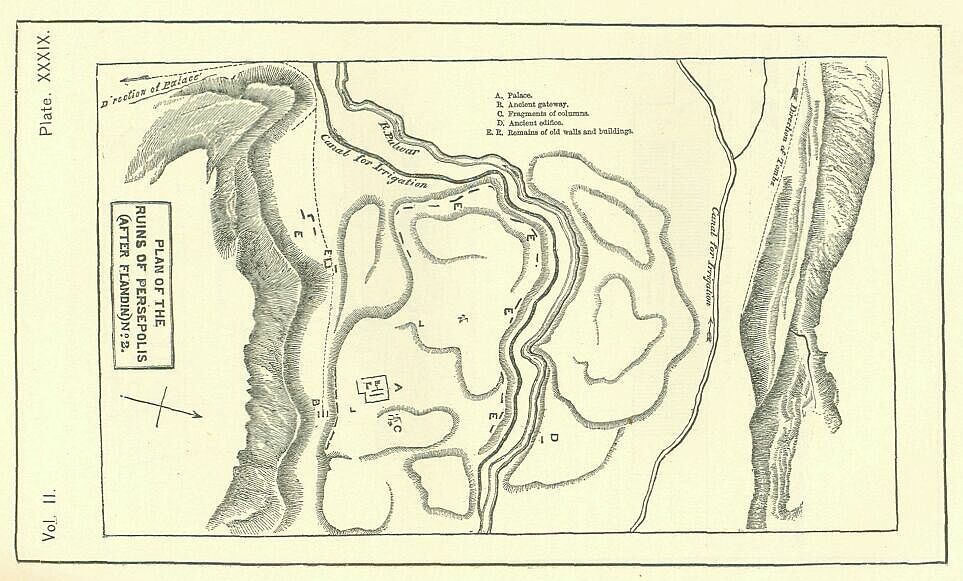
The platform at Persepolis is built at the foot of a high range of rocky hills, on which it abuts towards the east. It is composed of solid masses of hewn stone, which were united by metal clamps, probably of iron or lead. The masses were not cut to a uniform size, nor even always to a right angle, but were fitted together with a certain amount of irregularity, which will be the best understood from the woodcut overleaf. Many of the blocks were of enormous size; and their quarrying, transport, and elevation to their present places, imply very considerable mechanical skill. They were laid so as to form a perfectly smooth perpendicular wall, the least height of which above the plain below is twenty feet. The outline of the platform was somewhat irregular. Speaking roughly, we may call it an oblong square, with a breadth about two thirds of its length; but this description, unless qualified, will give an idea of far greater uniformity than actually prevails. [PLATE XL., Fig. 1.] The most serious irregularity is on the north side, the general line of which is not parallel to the south side, nor at right angles with the western one, but forms with the general line of the western an angle of about eighty degrees. The cause of this deviation lay probably in the fact that, on this side, a low rocky spur ran out from the mountain-range in this direction, and that it was thought desirable to accommodate the line of the structure to the natural irregularities of the ground. In addition to the irregularity of general outline thus produced, there is another of such perpetual occurrence that it must be regarded as an essential element of the original design, and therefore probably as approving itself to the artistic notions of the builder. This is the occurrence of frequent angular projections and indentations, which we remark on all three sides of the platform equally, and which would therefore seem to have been regarded in Persia, no less than in Assyria, as ornamental.
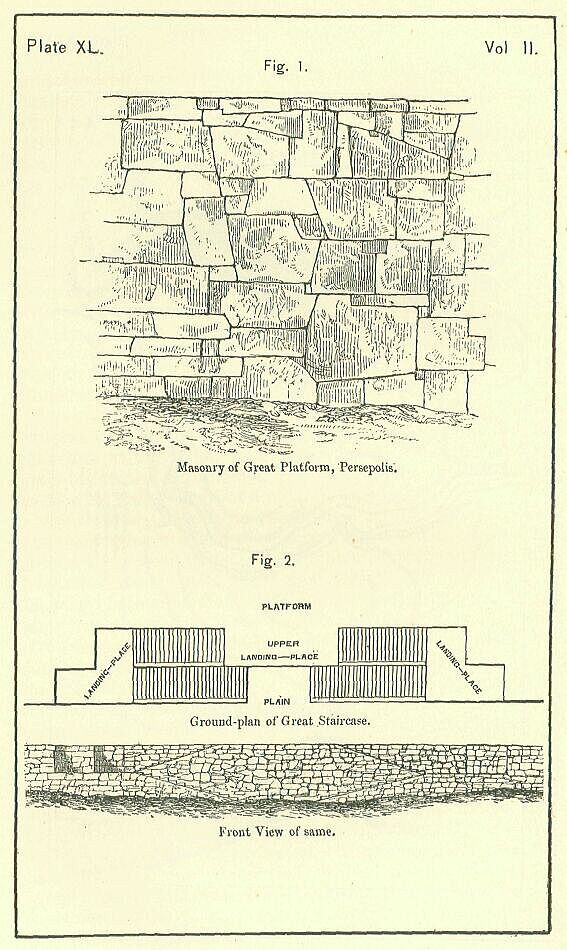
The whole of the platform is not of a uniform height. On the contrary, it seems to have been composed, as originally built, of several quite distinct terraces. Three of these still remain, exhibiting towards the west a very marked difference of elevation. The lowest of the three is on the south side, and it may therefore be termed the Southern Terrace. It extends from east to west a distance of about 800 feet, with a width of about 170 or 180, and has an elevation above the plain of from twenty to twenty-three feet. Opposite to this, on the northern side of the platform, is a second terrace, more than three times the breadth of the southern one, which may be called, by way of distinction, the Northern Terrace. This has an elevation above the plain of thirty-five feet. Intermediate between these two is the great Central or Upper Terrace, standing forty-five feet above the plain, having a length of 770 feet along the west face of the platform, and a width of about 400. Upon this Upper Terrace were situated almost all the great and important buildings.
The erection of a royal residence on a platform composed of several terraces involved the necessity of artificial ascents, which the Persian architects managed by means of broad and solid staircases. These staircases constitute one of the most remarkable features of the place, and seem to deserve careful and exact description. [PLATE XLI., Fig. 2.]
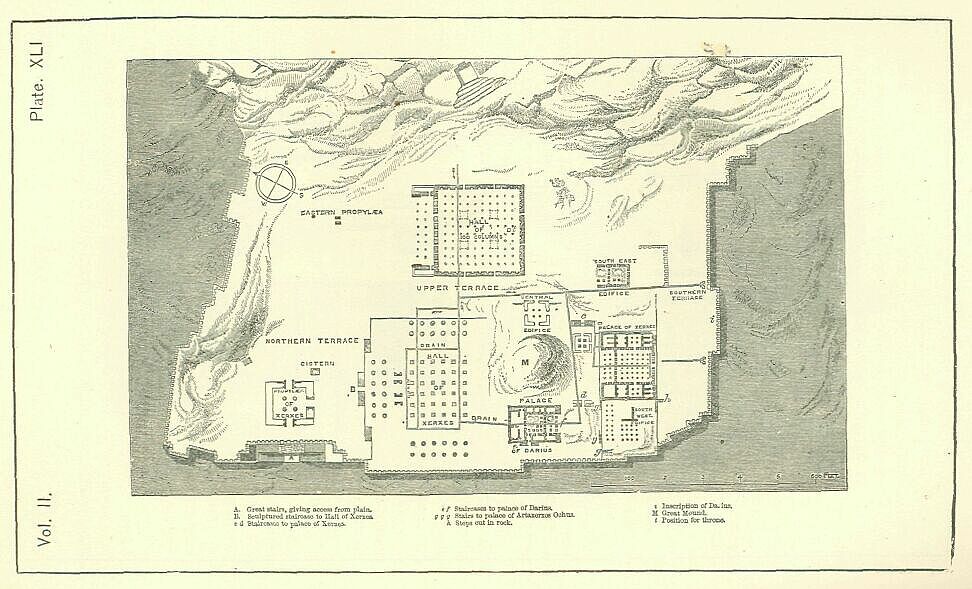
The first, and grandest in respect of scale, is on the west front of the platform towards its northern end, and leads up from the plain to the summit of the northern terrace, furnishing the only means by which the platform can even now be ascended. It consists of two distinct sets of steps, each composed of two flights, with a broad landing-place between them, the steps themselves running at right angles to the platform wall, and the two lower flights diverging, while the two upper ones converge to a common landing-place on the top. The slope of the stairs is so gentle that, though each step has a convenient width, the height of a step is in no case more than from three to four inches. It is thus easy to ride horses both up and down the staircase, and travellers are constantly in the habit of ascending and descending it in this way.
The width of the staircase is twenty-two feet—space sufficient to allow of ten horsemen ascending each flight of steps abreast. Altogether this ascent, which is on a plan unknown elsewhere, is pronounced to be the noblest example of a flight of stairs to be found in any part of the world. It does not project beyond the line of the platform whereto it leads, but is, as it were, taken out of it. [PLATE XLII.]
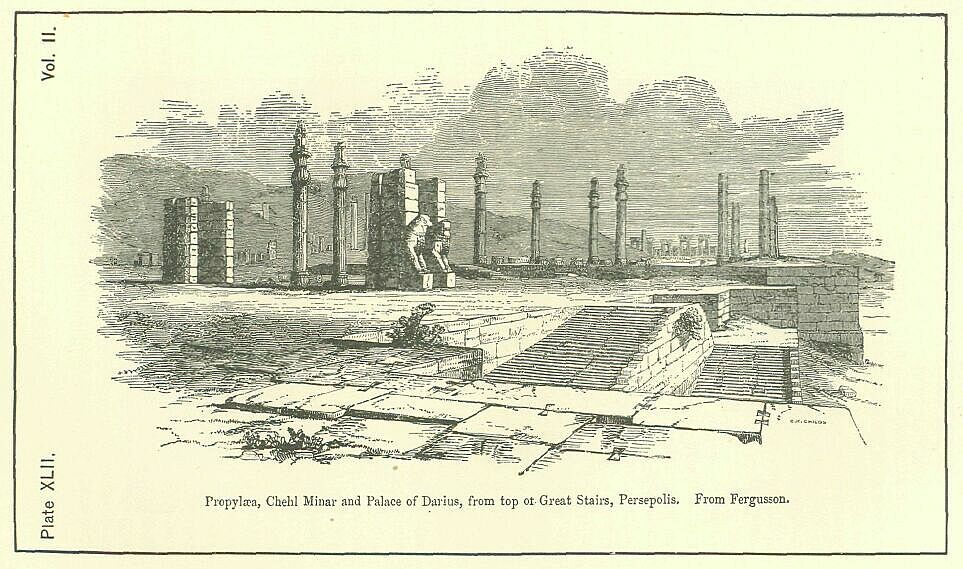
The next, and in some respects the most remarkable of all the staircases, conducts from the level of the northern platform to that of the central or upper terrace. This staircase fronts northward, and opens on the view as soon as the first staircase (A on the plan) has been ascended, lying to the right of the spectator at the distance of about fifty or sixty yards. It consists of four single flights of steps, two of which are central, facing one another, and leading to a projecting landing-place (B), about twenty feet in width; while the two others are on either side of the central flights, distant from them about twenty-one yards. The entire length of this staircase is 212 feet; its greatest projection in front of the line of the terrace whereon it abuts, is thirty-six feet. The steps, which are sixteen feet wide, rise in the same gentle way as those of the lower or platform staircase. The height of each is under four inches; and thus there are thirty-one steps in an ascent of ten feet.
The feature which specially distinguishes this staircase from the lower one already described is its elaborate ornamentation. The platform staircase is perfectly plain. The entire face which this staircase presents to the spectator is covered with sculptures. In the first place, on the central projection, which is divided perpendicularly into three compartments, are represented, in the spandrels on either side, a lion devouring a bull, and in the compartment between the spandrels eight colossal Persian guardsmen, armed with spears and either with sword or shield. Further, above the lion and bull, towards the edge of the spandrel where it slopes, forming a parapet to the steps, [PLATE XLIII., Fig. 1.] there was a row of cypress trees, while at the end of the parapet and along the whole of its inner face were a set of small figures, guardsmen habited like those in the central compartment, but carrying mostly a bow and quiver instead of a shield. Along the extreme edge of the parapet externally was a narrow border thickly set with rosettes. [PLATE XLIII., Fig. 2.] Next, in the long spaces between the central stairs and those on either side of them, the spandrels contain repetitions of the lion and bull sculpture, while between them and the central stairs the face of the wall is divided horizontally into three bands, each of which has been ornamented with a continuous row of figures. The highest row of the three is unfortunately mutilated, the upper portion of all the bodies being lost in consequence of their having been sculptured upon a parapet wall built originally to protect the edge of the terrace, but now fallen away. The middle and lowest rows are tolerably perfect, and possess considerable interest, as well as some artistic merit. The entire scene represented on the right side seems to be the bringing of tribute or presents to the monarch by the various nations under his sway. On the left-hand side this subject was continued to a certain extent; but the greater part of the space was occupied by representations of guards and officers of the court, the guards being placed towards the centre, and, as it were, keeping the main stairs, while the officers were at a greater distance. The three rows of figures were separated from one another by narrow bands, thickly set with rosettes.
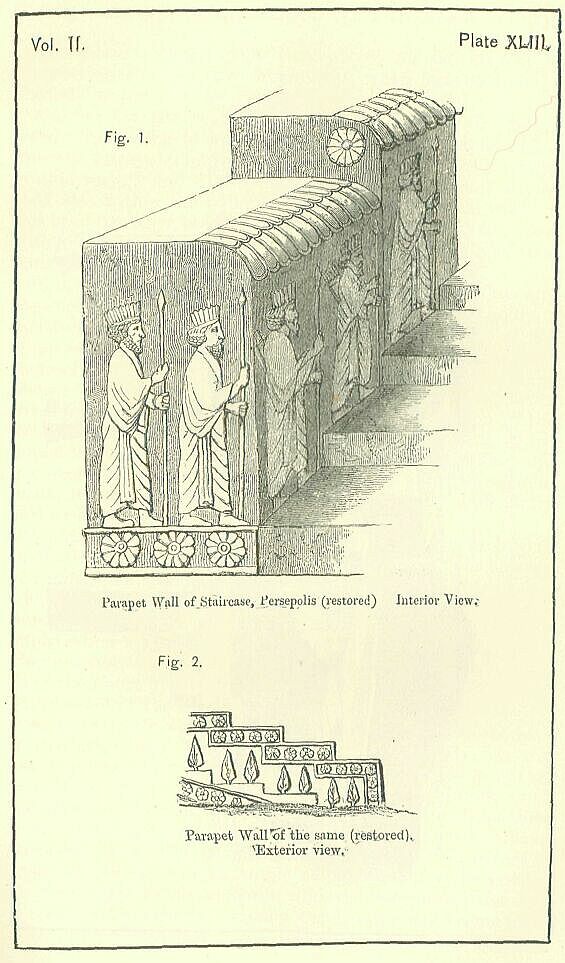
The builder of this magnificent work was not content to leave it to history or tradition to connect his name with his construction, but determined to make the work itself the means of perpetuating his memory. In three conspicuous parts of the staircase, slabs were left clear of sculpture, undoubtedly to receive inscriptions commemorative of the founder. The places selected were the front of the middle staircase, the exact centre of the whole work, and the space adjoining the spandrels to the extreme right and the extreme left. In one instance alone, however, was this part of the work completed. On the right hand, or western extremity of the staircase, an inscription of thirty lines in the old Persian language informs us that the constructor was "Xerxes, the Great King, the King of Kings, the son of King Darius, the Achaemenian." The central and left-hand tablets, intended probably for Babylonian and Scythic translations of the Persian legend, were never inscribed, and remain blank to the present day.
The remaining staircases will not require very lengthy or elaborate descriptions. They are six in number, and consist, in most instances, of a double flight of steps, similar to the central portion of the staircase which has been just described. Two of them (e and f) belonged to the building marked as the "Palace of Darius" on the plan, and gave entrance to it from the central platform above which it is elevated about fourteen or fifteen feet. Two others (c and d) belonged to the "Palace of Xerxes." These led up to a broad paved space in front of that building, which formed a terrace, elevated about ten feet above the general level of the central platform. Their position was at the two ends of the terrace, opposite to one another; but in other respects they cannot be said to have matched. The eastern, which consisted of two double flights, was similar in general arrangement to the staircase by which the platform was mounted from the plain, excepting that it was not recessed, but projected its full breadth beyond the line of the terrace. It was decidedly the more elegant of the two, and evidently formed the main approach. It was adorned with the usual bull and lion combats, with figures of guardsmen, and with attendants carrying articles needed for the table or the toilet. The inscriptions upon it declare it to be the work of Xerxes. [PLATE XLIV.] The western staircase was composed merely of two single flights, facing one another, with a narrow landing-place between them. It was ornamented like the eastern, but somewhat less elaborately.
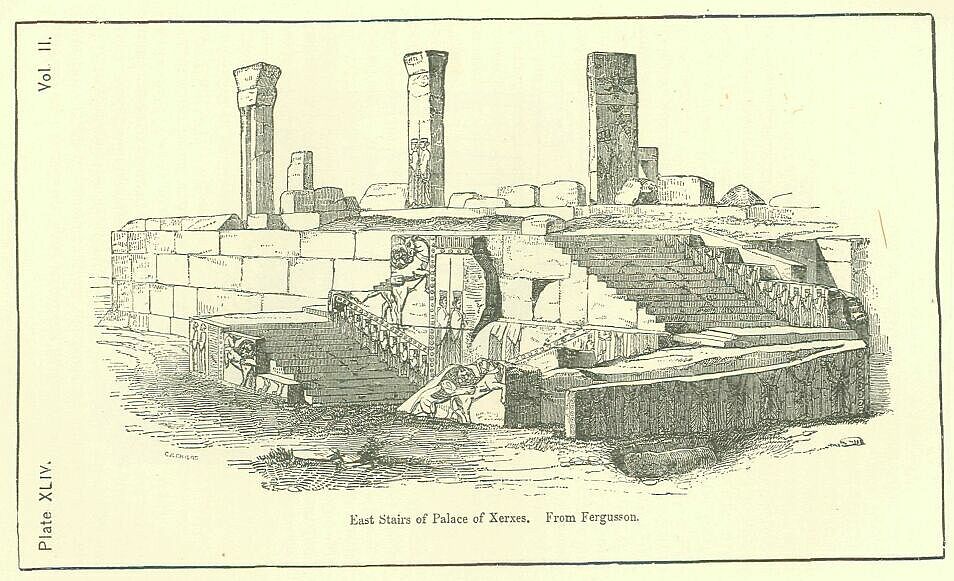
A staircase, very similar to this last, but still one with certain peculiarities, was built by Artaxerxes Ochus, at the west side of the Palace of Darius, in order to give it a second entrance. [PLATE XLV., Fig. 1.] There the spandrels have the usual figures of the lion and bull; but the intermediate space is somewhat unusually arranged. It is divided vertically and horizontally into eight squared compartments, three on either side, and two in the middle. The upper of these two contains nothing but a winged circle, the emblem of Divinity being thus placed reverently by itself. Below, in a compartment of double size, is an inscription of Ochus, barbarous in language, but very religious in tone. The six remaining compartments had each four figures, representing tribute-bearers introduced to the royal presence by a court officer.
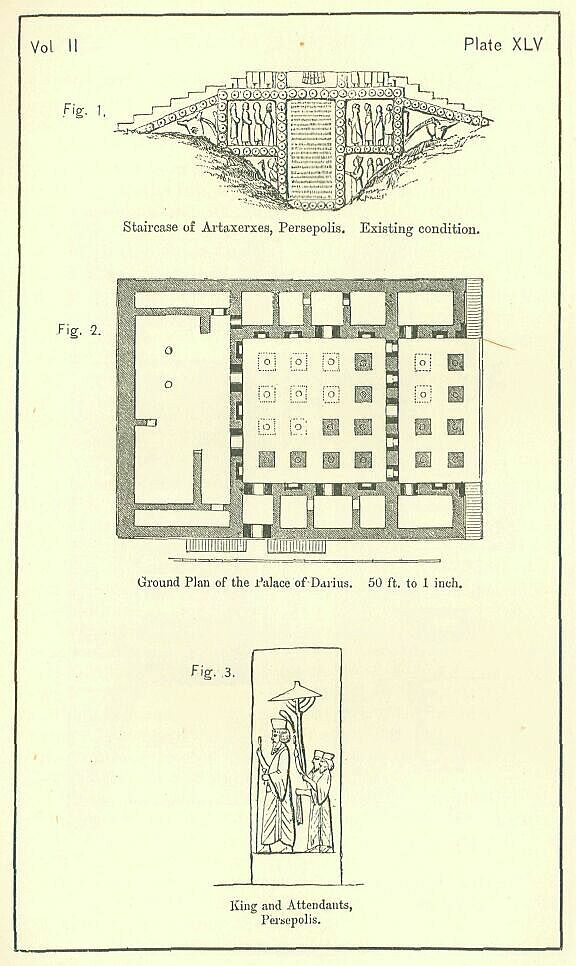
The other, and original, staircase to this palace (f on the plan) was towards the north, and led up to the great portico, which was anciently its sole entrance. Two flights of steps, facing each other, conducted to a paved space of equal extent with the portico and projecting in front of it about five feet. On the base of the staircase were sculptures in a single line—the lion and bull in either spandrel—and between the spandrels eighteen colossal guardsmen, nine facing either way towards a central inscription, which was repeated in other languages on slabs placed between the guardsmen and the bulls. Above the spandrels, on the parapet which fenced the stairs, was a line of figures representing attendants bringing into the palace materials for the banquet. A similar line adorned the inner wall of the staircase.
Opposite to this, at the distance of about thirty-two yards, was another very similar staircase, leading up to the portico of another building, erected (apparently) by Artaxerxes Ochus, which occupied the south-western corner of the upper platform. The sculptures here seem to have been of the usual character but they are so mutilated that no very decided opinion can be passed upon them.
Last of all, a staircase of a very peculiar character, (h on the plan) requires notice. This is a flight of steps cut in the solid rock, which leads up from the southern terrace to the upper one, at a point intervening between the south-western edifice, or palace of Artaxerxes, and the palace of Xerxes, or central southern edifice. These steps are singular in facing the terrace to which they lead, instead of being placed sideways to it. They are of rude construction, being without a parapet, and wholly devoid of sculpture or other ornamentation. They furnish the only communication between the southern and central terraces.
It is a peculiarity of the Persepolitan ruins that they are not continuous, but present to the modern inquirer the appearance, at any rate, of a number of distinct buildings. Of these the platform altogether contains ten, five of which are of large size, while the remainder are comparatively insignificant.
Of the five large buildings four stand upon the central or upper terrace, while one lies east of that terrace, between it and the mountains. The four upon the central terrace comprise three buildings made up of several sets of chambers, together with one great open pillared hall, to which are attached no subordinate apartments. The three complex edifices will be here termed "palaces," and will take the names of their respective founders, Darius, Xerxes, and Artaxerxes Ochus: the fourth will be called the "Great Hall of Audience." The building between the upper terrace and the mountains will be termed the "Great Eastern Edifice."
The "Palace of Darius," which is one of the most interesting of the Persepolitan buildings, stands near the western edge of the platform, midway between the "Great Hall of Audience" and the "Palace of Artaxerxes Ochus." [PLATE XLVI., Fig. 1.] It is a building about one hundred and thirty five feet in length, and in breadth a little short of a hundred. Of all the existing buildings on the platform it occupies the most exalted position, being elevated from fourteen to fifteen feet above the general level of the central terrace, and being thus four or five feet higher than the "Palace of Xerxes." It fronted towards the south, where it was approached by a double staircase of the usual character, which led up to a deep portico of eight pillars arranged in two rows. On either side of the portico were guard-rooms, which opened upon it, in length twenty-three feet, and in breadth thirteen. Behind the portico lay the main chamber, which was a square of fifty feet, having a roof supported by sixteen pillars, arranged in four rows of four, in line with the pillars of the portico. [PLATE XLV., Fig. 2.] The bases for the pillars alone remain; and it is thus uncertain whether their material was stone or wood. They were probably light and slender, not greatly interrupting the view. The hall was surrounded on all sides by walls from four to five feet in thickness, in which were doors, windows, and recesses, symmetrically arranged. The entrance from the portico was by a door in the exact centre of the front wall, on either side of which were two windows, looking into the portico. The opposite, or back, wall was pierced by two doors, which faced the intercolumniations of the side rows of pillars, as the front door faced the intercolumniation of the central rows. Between the two doors which pierced the back wall was a squared recess, and similar recesses ornamented the same wall on either side of the doors. The side walls were each pierced originally by a single doorway, between which and the front wall was a squared recess, while beyond, between the doorways and the back wall, were two recesses of the same character. Curiously enough, these side doorways and recesses fronted the pillars, not the intercolumniations.
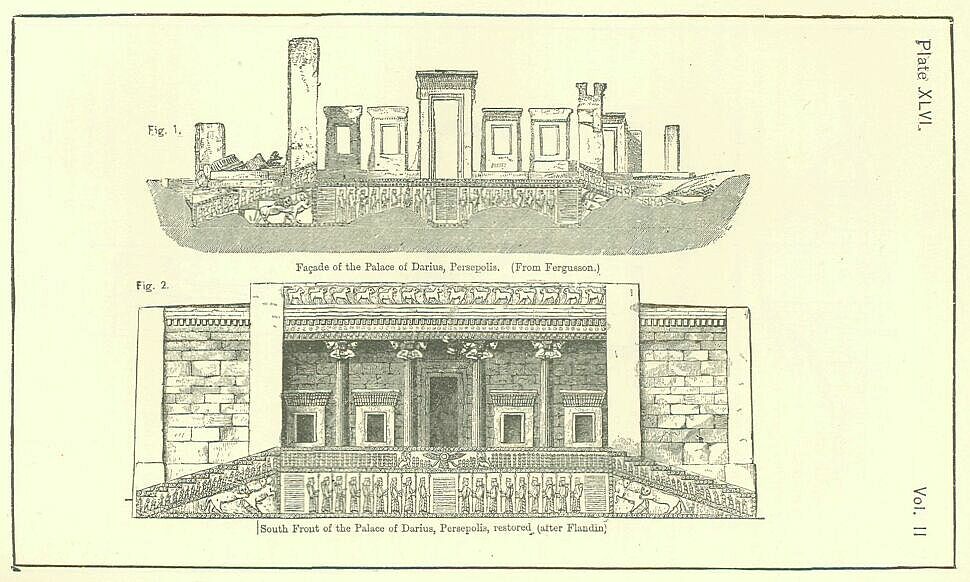
No sculpture, so far as appears, adorned this apartment, excepting in the doorways, which however had in every case this kind of ornamentation. The doorways in the back wall exhibited on their jambs figures of the king followed by two attendants, one holding a cloth, and the other a fly-chaser. [PLATE XLV., Fig. 3.] These figures had in every case their faces turned towards the apartment. The front doorway showed on its jambs the monarch followed by the parasol-bearer and the bearer of the fly-chaser, with his back turned to the apartment, issuing forth, as it were, from it. On the jambs of the doors of the side apartments was represented the king in combat with a lion or a monster, the king here in every case facing outwards, and seeming to guard the entrances to the side chambers.
At the back of the hall, and at either side, were chambers of very moderate dimensions. The largest were to the rear of the building, where there seems to have been one about forty feet by twenty-three, and another twenty-eight feet by twenty. The doorways here had sculptures, representing attendants bearing napkins and perfumes. The side chambers, five in number, were considerably smaller than those behind the great hall, the largest not exceeding thirty-four feet by thirteen.
It seems probable that this palace was without any second story. There is no vestige in any part of it of a staircase—no indication of its height having ever exceeded from twenty-two to twenty-five feet. It was a modest building, simple and regular, covering less than half the space of an ordinary palace in Assyria. [PLATE XLV., Fig. 2.] Externally, it must have presented an appearance not very dissimilar to that of the simpler Greek temples; distinguished from them by peculiarities of ornamentation, but by no striking or important feature, excepting the grand and elaborately sculptured staircase. Internally, it was remarkable for the small number of its apartments, which seem not to have been more than twelve or thirteen, and for the moderate size of most of them. Even the grand central hall covered a less area than three out of the five halls in the country palace of Sargon. The effect of this room was probably fine, though it must have been somewhat over-crowded with pillars. If these were, however (as is probable), light wooden posts, plated with silver or with gold, and if the ceiling consisted (as it most likely did) of beams, crossing each other at right angles, with square spaces between them, all likewise coated with the precious metals; if moreover the cold stone walls, excepting where they were broken by a doorway, or a window, were similarly decked; if curtains of brilliant hues hung across the entrances; if the pavement was of many-colored stones, and in places covered with magnificent carpets; if an elevated golden throne, under a canopy of purple, adorned the upper end of the room, standing against the wall midway between the two doors—if this were in truth the arrangement and ornamentation of the apartment, we can well understand that the coup d'oeil must have been effective, and the impression made on the spectator highly pleasing. A room fifty feet square, and not much more than twenty high, could not be very grand; but elegance of form, combined with richness of material and splendor of coloring, may have more than compensated for the want of that grandeur which results from mere size.
If it be inquired how a palace of the dimensions described can have sufficed even for one of the early Persian kings, the reply must seemingly be that the building in question can only have contained the public apartments of the royal residence—the throne-room, banqueting-rooms, guard-rooms, etc.,—and that it must have been supplemented by at least one other edifice of a considerable size, the Gynaeceum or "House of the Women." There is ample room on the platform for such a building, either towards the east, where the ground is now occupied by a high mound of rubbish, or on the west, towards the edge of the platform, where traces of a large edifice were noted by Niebuhr. On the whole, this latter situation seems to be the more probable; and the position of the Gynaeceum in this quarter may account for the alteration made by Artaxerxes Ochus in the palace of Darius, which now seriously interferes with its symmetry. Artaxerxes cut a doorway in the outer western wall, and another opposite to it in the western wall of the great hall, adding at the same time a second staircase to the building, which thus became accessible from the west no less than from the south. It has puzzled the learned in architecture to assign a motive for this alteration. May we not find an adequate one in the desire to obtain a ready and comparatively private access to the Gynaeceum, which must have been somewhere on the platform, and which may well have lain in this direction?
The minute account which has been now given of this palace will render unnecessary a very elaborate description of the remainder. Two grand palatial edifices seem to have been erected on the platform by later kings—one by Xerxes and the other by Artaxerxes Ochus; but the latter of these is in so ruined a condition, and the former is so like the palace of Darius, that but few remarks need be made upon either. The palace of Xerxes is simply that of Darius on a larger scale, the pillars in the portico being increased from two rows of four to two rows of six, and the great hall behind being a square of eighty instead of a square of fifty feet, with thirty-six instead of sixteen pillars to support its roof. On either side of the hall, and on either side of the portico, were apartments like those already described as abutting on the same portions of the older palace, differing from them chiefly in being larger and more numerous. The two largest, which were thirty-one feet square, had roofs supported on pillars, the numbers of such supports being in each case four. The only striking difference in the plans of the two buildings consisted in the absence from the palace of Xerxes of any apartments to the rear of the great hall. In order to allow space for an ample terrace in front, the whole edifice was thrown back so close to the edge of the upper platform that no room was left for any chambers at the back, since the hall itself was here brought almost to the very verge of the sheer descent from the central to the low southern terrace. In ornamentation the palaces also very closely resembled each other, the chief difference being that the combats of the king with lions and mythological monsters, which form the regular ornamentation of the side-chambers in the palace of Darius, occur nowhere in the residence of his son, where they are replaced by figures of attendants bringing articles for the toilet or the table, like those which adorn the main staircase of the older edifice. Figures of the same kind also ornament all the windows in the palace of Xerxes. A tone of mere sensual enjoyment is thus given to the later edifice, which is very far from characterizing the earlier; and the decline of morals at the Court, which history indicates as rapid about this period, is seen to have stamped itself, as such changes usually do, upon the national architecture.
A small building, at the distance of about twenty or twenty-five yards from the eastern wall of the palace of Xerxes, possesses a peculiar interest, in consequence of its having some claims to be considered the most ancient structure upon the platform. It consists of a hall and portico, in size, proportions, and decoration almost exactly resembling the corresponding parts of Darius's palace, but unaccompanied by any trace of circumjacent chambers, and totally devoid of inscriptions. The building is low, on the level of the northern, rather than on that of the central terrace, and is indeed half buried in the rubbish which has accumulated at its base. Its fragments are peculiarly grand and massive, while its sculptures are in strong and bold relief. There can be little doubt but that it was originally, like the hall and portico of Darius, surrounded on three sides by chambers. These, however, have entirely disappeared, having probably been pulled down to furnish materials for more recent edifices. Like the palaces of Xerxes and Artaxerxes Ochus, and unlike the palace of Darius, the building faces to the north, which is the direction naturally preferred in such a climate. We may suppose it to have been the royal residence of the earlier times, the erection of Cyrus or Cambyses, and to have been intended especially for summer use, for which its position well fitted it. Darius, wishing for a winter palace at Persepolis, as well as a summer one, took probably this early palace for his model, and built one as nearly as possible resembling it, except that, for the sake of greater warmth, he made his new erection face southwards. Xerxes, dissatisfied with the size of the old summer palace, built a new one at its side of considerably larger dimensions, using perhaps some of the materials of the old palace in his new building. Finally, Artaxerxes Ochus made certain additions to the palace of Xerxes on its western side, and at the same time added a staircase and a doorway to the winter residence of Darius. Thus the Persepolitan palace, using the word in its proper sense of royal residence, attained its full dimensions, occupying the southern half of the great central platform, and covering with its various courts and buildings a space 500 feet long by 375 feet wide, or nearly the space covered by the less ambitious of the palaces of Assyria.
Besides edifices adapted for habitation, the Persepolitan platform sustained two other classes of buildings. These were propylaea, or gateways—places commanding the approach to great buildings, where a guard might be stationed to stop and examine all comers—and halls of a vast size, which were probably throne-rooms, where the monarch held his court on grand occasions, to exhibit himself in full state to his subjects. The propylaea upon the platform appear to have been four in number. One, the largest, was directly opposite the centre of the landing-place at the top of the great stairs which gave access to the platform from the plain. This consisted of a noble apartment, eighty-two feet square, with a roof supported by four magnificent columns, each between fifty and sixty feet high. The walls of the apartment were from sixteen to seventeen feet thick. Two grand portals, each twelve feet wide by thirty-six feet high, led into this apartment, one directly facing the head of the stairs, and the other opposite to it, towards the east. Both were flanked with colossal bulls, those towards the staircase being conventional representations of the real animal, while the opposite pair are almost exact reproductions of the winged and human-headed bulls, with which the Assyrian discoveries have made us so familiar. The accompanying illustration [PLATE XLVII., Fig. 1.], which is taken from a photograph, exhibits this inner pair in their present condition. The back of one of the other pair is also visible. Two of the pillars—which alone are still standings appear in their places, intervening between the front and the back gateway.
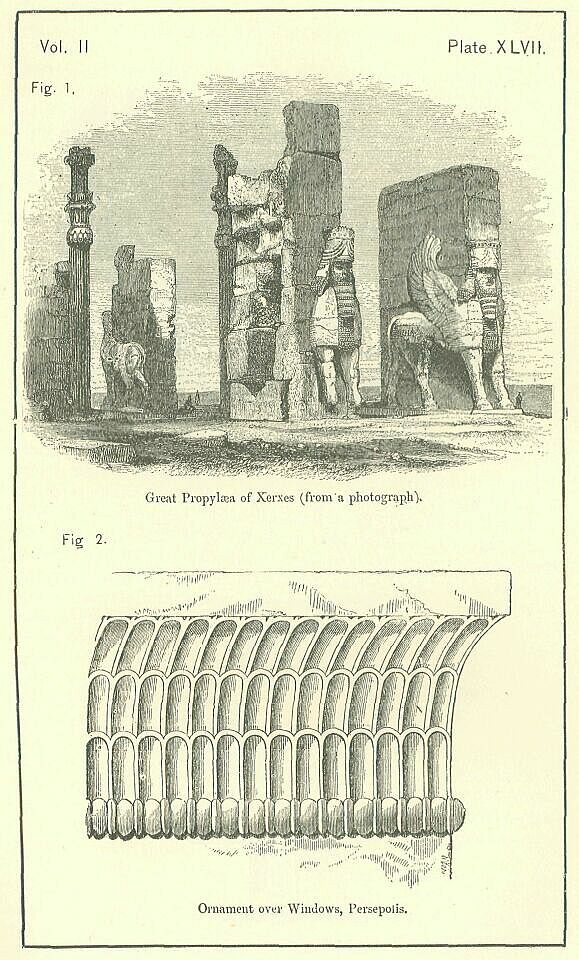
The walls which enclosed this chamber, notwithstanding their immense thickness, have almost entirely disappeared. On the southern side alone, where there seems to have been a third doorway, unornamented, are there any traces of them. We must conclude that they were either of burnt brick or of small blocks of stone, which the natives of the country in later times found it convenient to use as material for their own buildings.
An edifice, almost exactly similar to this, but of very inferior dimensions, occupied a position due east of the palace of Darius, and a little to the north of the main staircase leading to the terrace in front of the palace of Xerxes. The bases of two pillars and the jambs of three doorways remain, from which it is easy to reconstruct the main building. Its position seems to mark it as designed to give entrance to the structure, whatever it was, which occupied the site of the great mound (M on the Plan) east of Darius's palace, and north of the palace of his son. The ornamentation, however, would rather connect it with the more eastern of the two great pillared halls, which will have to be described presently.
A third edifice of the same kind stood in front of the great eastern hall, at the distance of about seventy yards from its portico. This building is more utterly ruined than either of the preceding, and its dimensions are open to some doubt. On the whole, it seems probable that it resembled the great propylaea at the head of the stairs leading from the plain rather than the central propylaea just described. Part of its ornamentation was certainly a colossal bull, though whether human-headed or not cannot be determined.
The fourth of the propylaea was on the terrace whereon stood the palace of Xerxes, and directly fronting the landing-place at the head of its principal stairs, just as the propylaea first described fronted the great stairs leading up from the plain. Its dimensions were suited to those of the staircase which led to it, and of the terrace on which it was placed. It was less than one fourth the size of the great propylaea, and about half that of the propylaea which stood the nearest to it. The bases of the four pillars alone remain in situ; but, from the proportions thus obtained, the position of the walls and doorways is tolerably certain.
We have now to pass to the most magnificent of the Perse-politan buildings—the Great Pillared Halls—which constitute the glory of Arian architecture, and which, even in their ruins, provoke the wonder and admiration of modern Europeans, familiar with all the triumphs of Western art, with Grecian temples, Roman baths and amphitheatres, Moorish palaces, Turkish mosques, and Christian cathedrals. Of these pillared halls, the Persepolitan platform supports two, slightly differing in their design, but presenting many points of agreement. They bear the character of an earlier and a later building—a first effort in the direction which circumstances compelled the architecture of the Persians to take, and the final achievement of their best artists in this kind of building.
Nearly midway in the platform between its northern and its southern edges, and not very far from the boundary of rocky mountain on which the platform abuts towards the east, is the vast edifice which has been called with good reason the "Hall of a Hundred Columns," since its roof was in all probability supported by that number of pillars. This building consisted of a single magnificent chamber, with a portico, and probably guard-rooms, in front, of dimensions quite unequalled upon the platform. The portico was 183 feet long by 52 feet deep, and was sustained by sixteen pillars, about 33 feet high, arranged in two rows of eight. The great chamber behind was a square of 227 feet, and had therefore an area of about 51,000 feet. Over this vast space were distributed, at equal distances from one another, one hundred columns, each 35 feet high, arranged in ten rows of ten each, every pillar thus standing at a distance of nearly 20 feet from any other. The four walls which enclosed this great hall had a uniform thickness of 10 1/2 feet, and were each pierced at equal intervals by two doorways, the doorways being thus exactly opposite to one another, and each looking down an avenue of columns. In the spaces of wall on either side of the doorways, eastward, westward, and southward, were three niches, all square-topped, and bearing the ornamentation which is universal in the case of all niches, windows, and doorways in the Persepolitan ruins. [PLATE XLVII., Fig. 2.] In the northern, or front, wall, the niches were replaced by windows looking upon the portico, excepting towards the angles of the building, where niches were retained, owing to a peculiarity in the plan of the edifice which has now to be noticed. The portico, instead of being, as in every other Persian instance, of the same width with the building which it fronted, was 44 feet narrower, its antce projecting from the front wall, not at either extremity, but at the distance of 11 feet from the corner. While the porch was thus contracted, so that the pillars had to be eight in each row instead of ten, space was left on either side for a narrow guard-room opening on to the porch, indications of which are seen in the doorways placed at right angles to the front wall, which are ornamented with the usual figures of soldiers armed with spear and shield. It has been suggested that the hall was, like the smaller pillared chambers upon the platform, originally surrounded on three sides by a number of lesser apartments; and this is certainly possible: but no trace remains of any such buildings. The ornamentation which exists seems to show that the building was altogether of a public character. Instead of exhibiting attendants bringing articles for the toilet or the banquet, it shows on its doors the monarch, either engaged in the art of destroying symbolical monsters, or seated on his throne under a canopy, with the tiara on his head, and the golden sceptre in his right hand. The throne representations are of two kinds. On the jambs of the great doors leading out upon the porch, we see in the top compartment the monarch seated under the canopy, accompanied by five attendants, while below him are his guards, arranged in five rows of ten each, some armed with spears and shields, others with spears, short swords, bows and quivers. Thus the two portals together exhibit the figures of 200 Persian guardsmen in attendance on the person of the king. The doors at the back of the building present us with a still more curious sculpture. On these the throne appears elevated on a lofty platform, the stages of which, three in number, are upheld by figures in different costumes, representing apparently the natives of all the different provinces of the Empire. It is a reasonable conjecture that this great hall was intended especially for a throne-room, and that in the representations on these doorways we have figured a structure which actually existed under its roof (probably at t in the plan)—a platform reached by steps, whereon, in the great ceremonies of state, the royal throne was placed, in order that the monarch might be distinctly seen at one and the same time by the whole Court.
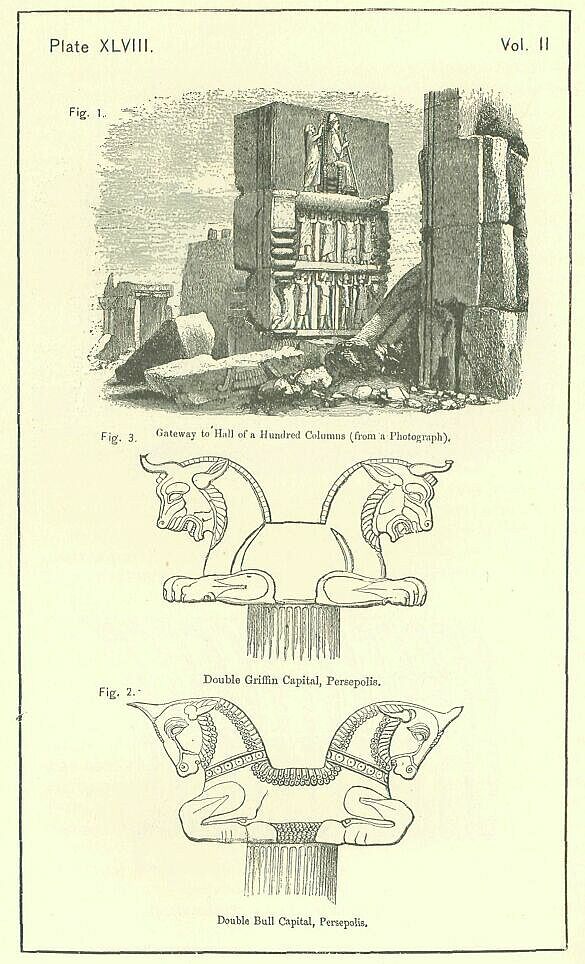
The question of the lighting of this huge apartment presents some difficulties. On three sides, as already observed, the hall had (so far as appears) no windows—the places where windows might have been expected to occur being occupied by niches. The apparent openings are consequently reduced to some fifteen, viz., the eight doorways, and seven windows, which looked out upon the portico, and were therefore overhung and had a north aspect. It is clear that sufficient light could not have entered the apartment from these—the only visible—apertures. We must therefore suppose either that the walls above the niches were pierced with windows, which is quite possible, or else that light was in some way or other admitted from the roof. The latter is the supposition of those most competent to decide. M. Flandin conjectures that the roof had four apertures, placed at the points where the lines drawn from the northern to the southern, and those drawn from the eastern to the western, doors would intersect one another. He seems to suppose that these openings were wholly unprotected, in which case they would have admitted, in a very inconvenient way, both the sun and the rain. May we not presume that, if such openings existed, they were guarded by louvres such as have been regarded as probably lighting the Assyrian halls, and of which a representation has already been given?
The portico of the Hall of a Hundred Columns was flanked on either side by a colossal bull, standing at the inner angle of the antes, and thus in some degree narrowing the entrance. Its columns were fluted, and had in every case the complex capital, which occurs also in the great propylaea and in the Hall of Xerxes. It was built of the same sort of massive blocks as the south-eastern edifice, or Ancient Palace—blocks often ten feet square by seven feet thick, and may be ascribed probably to the same age as that structure. Like that edifice, it is situated somewhat low; it has no staircase, and no inscription. We may fairly suppose it to have been the throne-room or great hall of audience of the early king who built the South-eastern Palace.
We have now to describe the most remarkable of all the Persepolitan edifices—a building the remains of which stretch nearly 350 feet in one direction, while in the other they extend 246 feet. Its ruins consist almost entirely of pillars, which are divided into four groups. The largest of these was a square of thirty-six pillars, arranged in six rows of six, all exactly equidistant from one another, and covering an area of above 20,000 square feet. On three sides of this square, eastward, northward, and westward, were magnificent porches, each consisting of twelve columns, arranged in two rows, in line with the pillars of the central cluster. These porches stood at the distance of seventy feet from the main building, and have the appearance of having been entirely separate from it. They are 143 feet long, by thirty broad, and thus cover each an area of 4260 feet. The most astonishing feature in the whole building is the height of the pillars. These, according to the measurements of M. Flandin, had a uniform altitude throughout the building of sixty-four feet. Even in their ruin, they tower over every other erection upon the platform, retaining often, in spite of the effects of time, an elevation of sixty feet.
The capitals of the pillars were of three kinds. Those of the side colonnades were comparatively simple: they consisted, in each case, of a single member, formed, in the eastern colonnade, of two half-griffins, with their heads looking in opposite directions [PLATE XLVII, Fig. 2]; and, in the western colonnade, of two half-bulls, arranged in the same manner [PLATE XLVII., Fig. 3]. The capitals of the pillars in the northern colonnade, which faced the great sculptured staircase, and constituted the true front of the building, were of a very complex character. They may be best viewed as composed of three distinct members—first, a sort of lotos-bud, accompanied by pendent leaves; then, above that, a member, composed of volutes like those of the Ionic order, but placed in a perpendicular instead of a horizontal direction; and at the top, a member composed of two half-bulls, exactly similar to that which forms the complete capital of the western group of pillars. The pillars of the groat central cluster had capitals exactly like those of the northern colonnade.
The bases of the colonnade pillars are of singular beauty. Bell-shaped, and ornamented with a double or triple row of pendent lotus-leaves, some rounded, some narrowed to a point; they are as graceful as they are rare in their forms, and attract the admiration of all beholders. Above them rise the columns, tapering gently as they ascend, but without any swell or entasis. They consist of several masses of stone, carefully joined together, and secured at the joints by an iron cramp in the direction of the column's axis. All are beautifully fluted along their entire length, the number of the incisions or flutings being from forty-eight to fifty-two in each pillar. They are arcs of circles smaller than semicircles, thus resembling those of the Doric, rather than those of the Ionic or Corinthian order. The cutting of all is very exact and regular.
There can be little doubt but that both the porches, and the great central pillar-cluster, were roofed in. The double-bull and double-griffin capital are exactly suited to receive the ends of beams, which would stretch from pillar to pillar, and support a roof and an entablature. [PLATE L., Fig.1.] We may see in the entrances to the royal tombs the true use of pillars in a Persian building, and the character of the entablature which, they were intended to sustain, Assuming, then, that both the great central pillar phalanx and the three detached colonnades supported a roof, the question arises, were the colonnades in any way united with the main building, or did they stand completely detached from it? It has been supposed that they were all porticos in antis, connected with the main building by solid walls—that the great central column-cluster was surrounded on all sides by a wall of a very massive description, from the four corners of which similar barriers were carried down to the edge of the terrace, abutting in front upon the steps of the great sculptured staircase, and extending eastward and westward, so as to form the antce of an eastern and a western portico. In the two corners between the northern in antae of the side porticos and the antae of the portico in front are supposed to have been large guard-rooms, entirely filling up the two angles. The whole building is thus brought into close conformity with the "Palace of Xerxes," from which it is distinguished only by its superior size, its use of stone pillars, and the elongation of the tetrastyle chambers at the sides of that edifice into porticos of twelve pillars each.
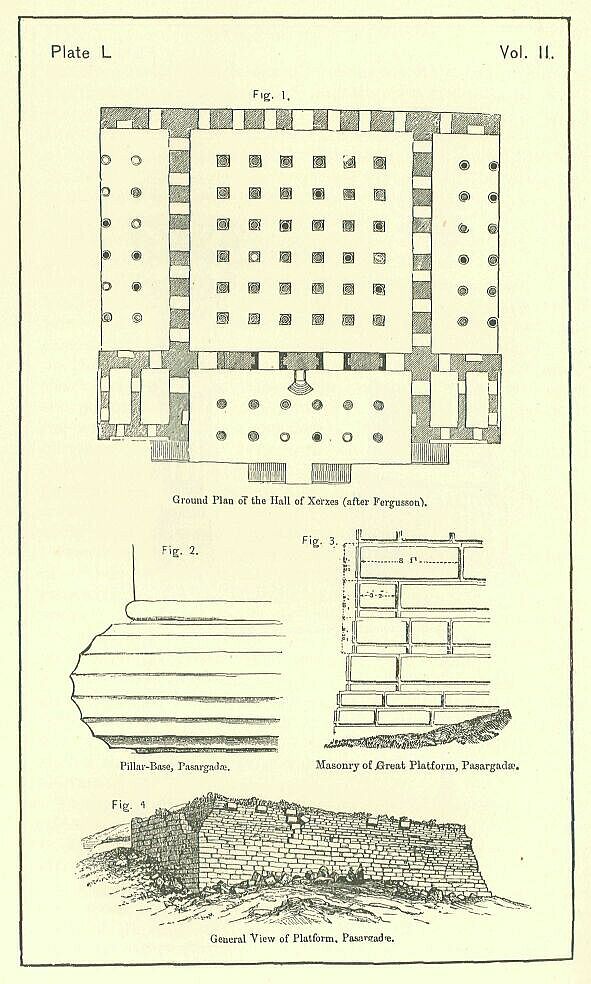
The ingenuity of this conception is unquestionable; and one is tempted at first sight to accept a solution which removes so much that is puzzling, and establishes so remarkable a harmony between works whose outward aspect is so dissimilar. It seems like the inspiration of genius to discern so clearly the like in the unlike, and one inclines at first to believe that what is so clever cannot but be true. But a rigorous examination of the evidence leads to an opposite conclusion, and if it does not absolutely disprove Mr. Fergusson's theory, at any rate shows it to be in the highest degree doubtful. Such walls as he describes, with their antae and their many doors and windows, should have left very marked traces of their existence in great squared pillars at the sides of porticos, in huge door-frames and window-frames, or at least in the foundations of walls, or, the marks of them, on some part of the paved terrace. Now the entire absence of squared pillars for the ends of antce, of door-frames, and window-frames, or even of such sculptured fragments as might indicate their former existence, is palpable and is admitted; nor is there any even supposed trace of the walls, excepting in one of the lines which by the hypothesis they would occupy. In front of the building, midway between the great pillar-cluster and the north colonnade, are the remains of four stone bases, parallel to one another, each seventeen feet long by five feet six inches wide. Mr. Fergusson regards these bases as marking the position of the doors in his front wall; and they are certainly in places where doors might have been looked for, if the building had a front wall, since the openings are exactly opposite the inter-columniations of the pillars, both in the portico and in the main cluster. But there are several objections to the notion of these bases being the foundations of the jambs of doors. In the first place, they are too wide apart, being at the distance from one another of seventeen feet, whereas no doorway on the platform exceeds a width of twelve or thirteen feet. In the second place, if these massive stone bases were prepared for the jambs of doors, it could only have been for massive stone jambs like those of the other palaces; but in that case, the jambs could not have disappeared. Thirdly, if the doorways on this side were thus marked, why were they not similarly marked on the other sides of the building? On the whole, the supposition of M. Flandin, that the bases were pedestals for ornamental statues, perhaps of bulls, seems more probable than that of Mr. Fergusson; though, no doubt, there are objections also to M. Flandin's hypothesis, and it would be perhaps best to confess that we do not know the use of these strange foundations, which have nothing that at all resembles them upon the rest of the platform.
Another strong objection to Mr. Fergusson's theory, and one of which he, to a certain extent, admits the force, is the existence of drains, running exactly in the line of his side walls, which, if such walls existed, would be a curious provision on the part of the architect for undermining his own work. Mr. Fergusson supposes that they might be intended to drain the walls themselves and keep them dry. But as it is clear that they must have carried off the whole surplus water from the roof of the building, and as there is often much rain and snow at Persepolis, their effect on the foundations of such a wall as Mr. Fergusson imagines would evidently be disastrous in the extreme.
To these minute and somewhat technical objections may be added the main one, whereof all alike can feel the force—namely, the entire disappearance of such a vast mass of building as Mr. Fergusson's hypothesis supposes. To account for this, Mr. Fergusson is obliged to lay it down, that in this magnificent structure, with its solid stone staircase, its massive pavement of the same material, and its seventy-two stone pillars, each sixty-four feet high, the walls were of mud. Can we believe in this incongruity? Can we imagine that a prince, who possessed an unbounded command of human labor, and an inexhaustible supply of stone in the rocky mountains close at hand, would have had recourse to the meanest of materials for the walls of an edifice which he evidently intended to eclipse all others upon the platform. And, especially, can we suppose this, when the very same prince used solid blocks of stone, in the walls of the very inferior edifice which he constructed in this same locality? Mr. Fergusson, in defence of his hypothesis, alleges the frequent combination of meanness with magnificence in the East, and softens down the meanness in the present case by clothing his mud walls with enamelled tiles, and painting them with all the colors of the rainbow. But here again the hypothesis is wholly unsupported by fact. Neither at Persepolis, nor at Pasargadae, nor at any other ancient Persian site, has a single fragment of an enamelled tile or brick been discovered. In Babylonia and Assyria, where the employment of such an ornamentation was common, the traces of it which remain are abundant. Must not the entire absence of such traces from all exclusively Persian ruins be held to indicate that this mode of adorning edifices was not adopted in Persia?
If then we resign the notion of this remarkable building having been a walled structure, we must suppose that it was a summer throne-room, open to all the winds of heaven, except so far as it was protected by curtains. For the use of these by the Persians in pillared edifices, we have important historical authority in the statement already quoted from the Book of Esther. The Persian palace, to which that passage directly refers, contained a structure almost the exact counterpart of this at Persepolis; and it is probable that at both places the interstices between the outer pillars of, at any rate, the great central colonnade, were filled with "hangings of white and green and blue, fastened with cords of white and purple to silver rings," which were attached to the "pillars of marble;" and that by these means an undue supply of light and air, as well as an unseemly publicity, were prevented. A traveller in the country well observes, in allusion to this passage from Esther: Nothing could be more appropriate than this method at Susa and Persepolis, the spring residences of the Persian monarchs. It must be considered that these columnar halls were the equivalents of the modern throne-rooms, that here all public business was dispatched, and that here the king might sit and enjoy the beauties of the landscape. With the rich plains of Susa and Persepolis before him, he could well, after his winter's residence at Babylon, dispense with massive walls, which would only check the warm fragrant breeze from those verdant prairies adorned with the choicest flowers. A massive roof, covering the whole expanse of columns, would be too cold and dismal, whereas curtains around the central group would serve to admit both light and warmth. Nothing can be conceived better adapted to the climate or the season.
If the central cluster of pillars was thus adapted to the purposes of a throne-room, equally well may the isolated colonnades have served as ante-chambers or posts for guards. Protected, perhaps, with curtains or awnings of their own, of a coarser material than those of the main chamber, or at any rate casting, when the sun was high, a broad and deep shadow, they would give a welcome shelter to those who had to watch over the safety of the monarch, or who were expecting but had not yet received their summons to the royal presence. Except in the very hottest weather, the Oriental does not love to pass his day within doors. Seated on the pavement in groups, under the deep shadows of these colonnades, which commanded a glorious view of the vast fertile plain of the Bendamir, of the undulating mountain-tract beyond, and of the picturesque hills known now as Koh-Istakhr, or Koh-Rhamgherd, the subjects of the Great King, who had business at Court, would wait, agreeably enough, till their turn came to approach the throne.
Our survey of the Persepolitan platform is now complete; but, before we entirely dismiss the subject of Persian palaces, it seems proper to say a few words with respect to the other palatial remains of Achasmenian times, remains which exist in three places—at Murgab or Pasargadse, at Istakr, and at the great mound of Susa. The Murgab and Istakr ruins were carefully examined by MM. Coste and Flandin; while General Williams and Mr. Loftus diligently explored, and completely made out, the plan of the Susian edifice.
The ruins at Murgab, which are probably the most ancient in Persia, comprise, besides the well-known "Tomb of Cyrus," two principal buildings. The largest of these was of an oblong-square shape, about 147 feet long by 116 wide. It seems to have been surrounded by a lofty wall, in which were huge portals, consisting of great blocks of stone, partially hollowed out, to render them portable. There was an inscription on the jambs of each portal, containing the words, "I am Cyrus the King, the Achaemenian." Within the walled enclosure which may have been skirted internally by a colonnade was a pillared building, of much greater height than the surrounding walls, as is evident from the single column which remains. This shaft, which is perfectly plain, and shows no signs of a capital, has an altitude of thirty-six feet, with a diameter of three feet four inches at the base. On the area around, which was carefully paved, are the bases of seven other similar pillars, arranged in lines, and so situated as apparently to indicate an oblong hall, supported by twelve pillars, in three rows of four each. The chief peculiarity of the arrangement is, a variety in the width of the intercolumniations, which measure twenty-seven feet ten inches in one direction, but twenty-one feet only in the other. The smaller building, which is situated at only a short distance from the larger one, covers a space of 125 feet by fifty. It consists of twelve pillar bases, arranged in two rows of six each, the pillars being somewhat thicker than those of the other building, and placed somewhat closer together. [PLATE XLIX., Fig. 5.] The form of the base is very singular. It exhibits at the side a semicircular bulge, ornamented with a series of nine flutings, which are carried entirely round the base in parallel horizontal circles. [PLATE L., Fig. 2.] In front of the pillar bases, at the distance of about twenty-three feet from the nearest, is a square column, still upright, on which is sculptured a curious mythological figure, together with the same curt legend, which appears on the larger building—"I am Cyrus, the King, the Achaemenian."
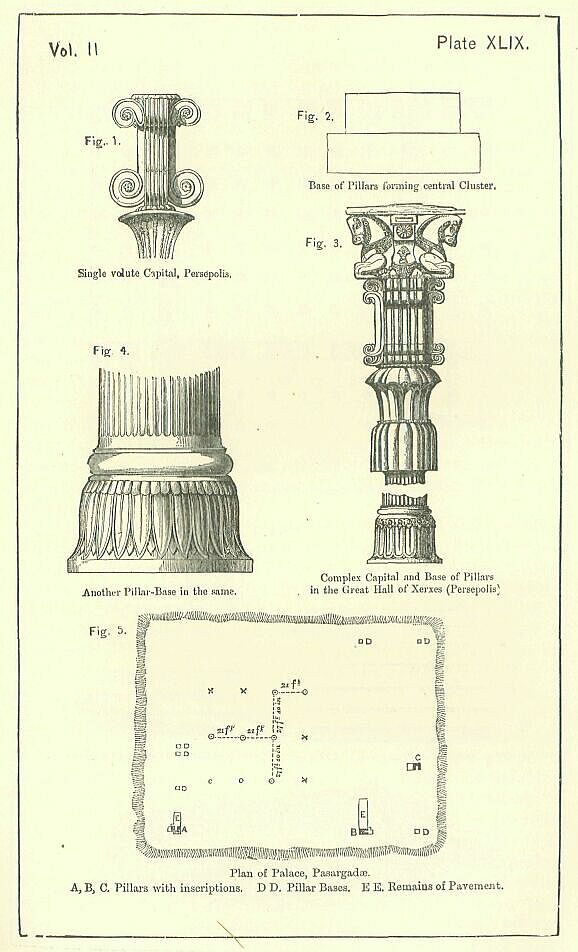
There are two other buildings at Murgab remarkable for their masonry. One is a square tower, with slightly projecting corners, built of hewn blocks of stone, very regularly laid, and carried to a height of forty-two feet. The other is a platform, exceedingly massive and handsome, composed entirely of squared stone, and faced with blocks often eight or ten feet long, laid in horizontal courses, and rusticated throughout in a manner that is highly ornamental. [PLATE L. Fig. 3.] The style resembles that of the substructions of the Temple of Jerusalem. It occurs occasionally, though somewhat rarely, in Greece; but there is said to exist nowhere so extensive and beautiful a specimen of it as that of the platform at this ancient site. [PLATE L., Fig. 4.]
The palace at Istakr is in better preservation than either of the two pillared edifices at Murgab; but still, it is not in such a condition as to enable us to lay down with any certainty even its ground-plan. [PLATE LI., Fig. 1.] One pillar only remains erect; but the bases of eight others have been found in situ; the walls are partly to be traced, and the jambs of several doorways and niches are still standing. These remains show that in many respects, as in the character of the pillars, which were fluted and had capitals like those already described, in the massiveness of the door and window jambs, and in the thickness of the walls, the Istakr Palace resembled closely the buildings on the Persepolitan platform; but at the same time they indicate that its plan was wholly different, and thus our knowledge of the platform buildings in no degree enables us to complete, or even to carry forward to any appreciable extent, the ground-plan of the edifice derived from actual research. The height of the columns, which is inferior to that of the lowest at the great platform, would seem to indicate, either that the building was the first in which stone pillars were attempted, or that it was erected at a time when the Persians no longer possessed the mechanical skill required to quarry, transport, and raise into place the enormous blocks used in the best days of the nation.
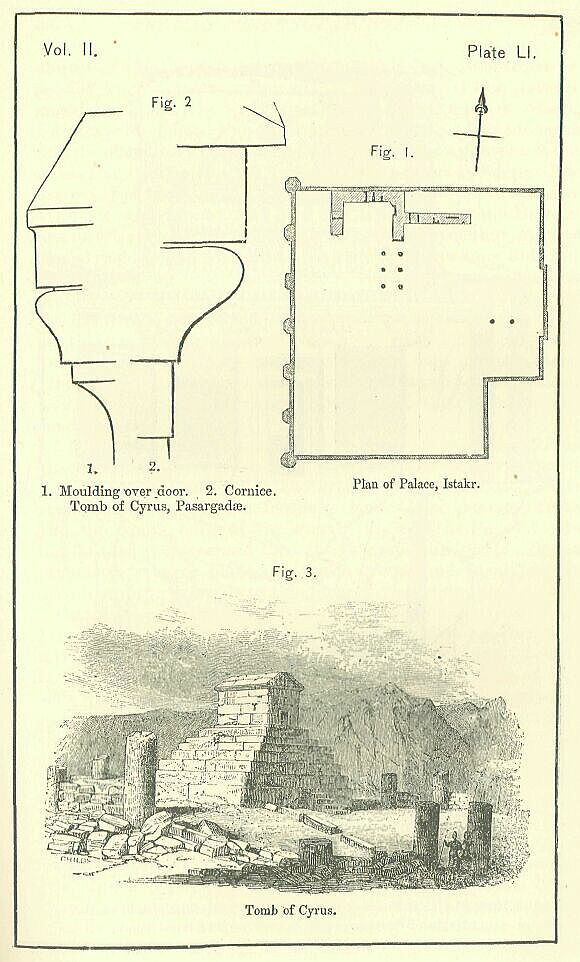
The palace of Susa, exhumed by Mr. Loftus and General Williams, consisted of a great Hall or Throne-room, almost exactly a duplicate of the Chehl Minar at Persepolis, and of a few other very inferior buildings. It stood at the summit of the great platform, a quadrilateral mass of unburnt brick, which from a remote antiquity had supported the residence of the old Susian kings. It fronted a little west of north, and commanded a magnificent view over the Susianian plains to the mountains of Lauristan. An inscription, repeated on four of its pillar-bases, showed that it was originally built by Darius Hystaspis, and afterwards repaired by Artaxerxes Longimanus. As it was so exactly a reproduction of an edifice already minutely described, no further account of it need be here given.
From the palaces of the Persian kings we may now pass to their tombs, remarkable structures which drew the attention of the ancients, and which have been very fully examined and represented in modern times. These tombs are eight in number, but present only two types, so that it will be sufficient to give in this place a detailed account of two tombs—one of each description.
The most ancient, and, on the whole, the most remarkable of the tombs, is almost universally allowed to be that of the Great Cyrus. It is unique in design, totally different from all the other royal sepulchres; and, though it has been often described, demands, and must receive, notice in any account that is given of the ancient Persian constructions. The historian Arrian calls it "a house upon a pedestal;" and this brief description exactly expresses its general character. On a base, composed of huge blocks of the most beautiful white marble,1 which rises pyramidically in seven steps of different heights, there stands a small "house" of similar material, crowned with a stone roof, which is formed in front and rear into a pediment resembling that of a Greek temple. [PLATE LI., Fig.3.] The "house" has no window, but one of the end walls was pierced by a low and narrow doorway, which led into a small chamber or cell, about eleven feet long, seven broad, and seven high. Here, as ancient writers inform us, the body of the Great Cyrus was deposited in a golden coffin. Internally the chamber is destitute of any inscription, and indeed seems to have been left perfectly plain. Externally, there is a cornice of some elegance below the pediment, a good molding over the doorway, which is also doubly recessed—and two other very slight moldings, one at the base of the "house," and the other at the bottom of the second step. [PLATE LI., Fig. 2.] Except for these, the whole edifice is perfectly plain. Its present height above the ground is thirty-six feet, and it may originally have been a foot or eighteen inches higher, for the top of the roof is worn away. It measures at the base forty-seven feet by forty-three feet nine inches.
The tomb stands within a rectangular area, marked out by pillars, the bases or broken shafts of which are still to be seen. They appear to have been twenty-four in number; all of them circular and smooth, not fluted; six pillars occupied each side of the rectangle, and they stood distant from each other about fourteen feet. It is probable that they originally supported a colonnade, which skirted internally a small walled court, within which the tomb was placed. The capitals of the pillars, if they had any, have wholly disappeared; and the researches conducted on the spot have failed to discover any trace of them.
The remainder of the Persian royal sepulchres are rock-tombs, excavations in the sides of mountains, generally at a considerable elevation, so placed as to attract the eye of the beholder, while they are extremely difficult of approach. Of this kind of tomb there are four in the face of the mountain which bounds the Pulwar Valley on the north-west, while there are three others in the immediate vicinity of the Persepolitan platform, two in the mountain which overhangs it, and one in the rocks a little further to the south. The general shape of the excavations, as it presents itself to the eye of the spectator, resembles a Greek cross. [PLATE LII., Fig. 1.] This is divided by horizontal lines into three portions, the upper one (corresponding with the topmost limb of the cross) containing a very curious sculptured representation of the monarch worshipping Ormazd; the middle one, which comprises the two side limbs, together with the space between them, being carved architecturally so as to resemble a portico; and the third compartment (corresponding with the lowest limb of the cross) being left perfectly plain. In the centre of the middle compartment is sculptured on the face of the rock the similitude of a doorway, closely resembling those which still stand on the great platform; that is to say, doubly recessed, and ornamented at the top with lily-work. The upper portion of this doorway is filled with the solid rock, smoothed to a flat surface and crossed by three horizontal bars. The lower portion, to the height of four or five feet, is cut away; and thus entrance is given to the actual tomb, which is hollowed out in the rock behind.
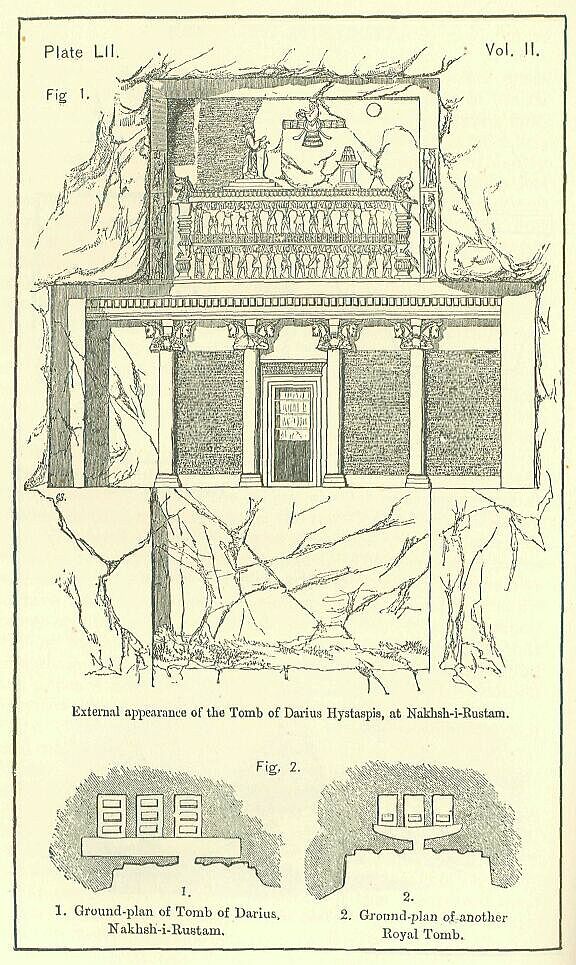
Thus far the rock tombs, are, with scarcely an exception, of the same type. The excavations, however, behind their ornamental fronts, present some curious differences. In the simplest case of all, we find, on entering, an arched chamber, thirteen feet five inches long by seven feet two inches wide, from which there opens out, opposite to the door and at the height of about four feet from the ground, a deep horizontal recess, arched, like the chamber. Near the front of this recess is a further perpendicular excavation, in length six feet ten inches, in width three feet three inches, and in depth the same. This was the actual sarcophagus, and was covered, or intended to be covered, by a slab of stone. In the deeper part of the recess there is room for two other such sarcophagi; but in this case they have not been excavated, one burial only having, it would seem, taken place in this tomb. Other sepulchres present the same general features, but provide for a much greater number of interments. In that of Darius Hystaspis the sepulchral chamber contains three distinct recesses, in each of which are three sarcophagi, so that the tomb would hold nine bodies. It has, apparently, been cut originally for a single recess, on the exact plan of the tomb described above, but has afterwards been elongated towards the left. [PLATE LIII., Fig. 1.] Two of the tombs show a still more elaborate ground-plan—one in which curved lines take to some extent the place of straight ones. [PLATE LII., Fig. 2.] The tombs above the platform of Persepolis are more richly ornamented than the others, the lintels and sideposts of the doorways being covered with rosettes, and the entablature above the cornice bearing a row of lions, facing on either side towards the centre. [PLATE LIII., Fig. 2.]
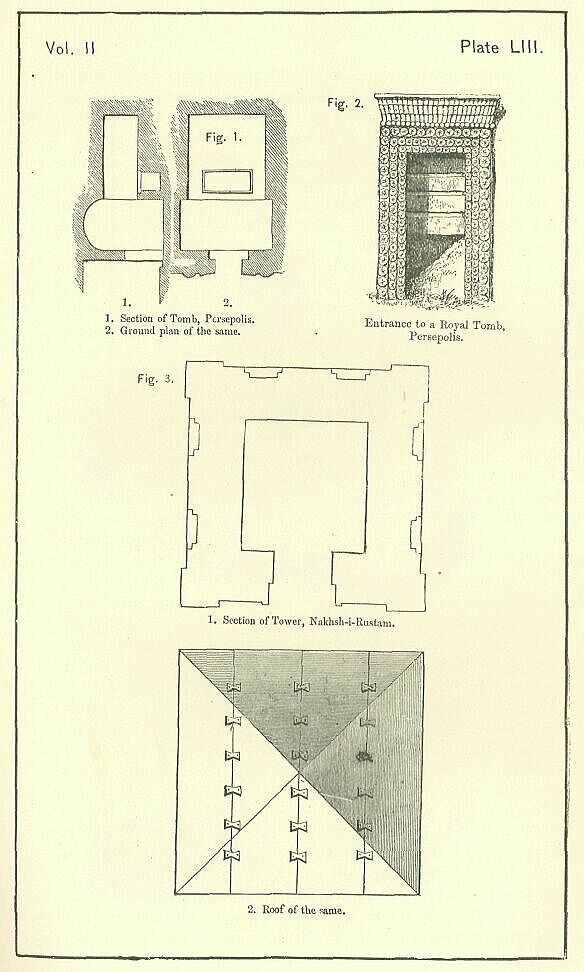
A curious edifice, belonging probably to the later Achaemenian times, stands immediately in front of the four royal tombs at Nakhsh-i-Eustam. This is a square tower, composed of large blocks of marble, cut with great exactness, and joined together without mortar or cement of any kind. The building is thirty-six feet high; and each side of it measures, as near as possible, twenty-four feet. It is ornamented with pilasters at the corners and with six recessed niches, or false windows, in three ranks, one over the other, on three out of its four faces. On the fourth face are two niches only, one over the other; and below them is a doorway with a cornice. The surface of the walls between the pilasters is also ornamented with a number of rectangular depressions, resembling the sunken ends of beams. The doorway, which looks north, towards the tombs, is not at the bottom of the building, but half-way up its side, and must have been reached either by a ladder or by a flight of steps. It leads into a square chamber, twelve feet wide by nearly eighteen high, extending to the top of the building, and roofed in with four large slabs of stone, which reach entirely across from side to side, being rather more than twenty-four feet long, six feet wide, and from eighteen inches to three feet in thickness. [PLATE LIII., Fig. 3.] On the top these slabs are so cut that the roof has every way a slight incline; at their edges they are fashioned between the pilasters, into a dentated cornice, like that which is seen on the tomb. Externally they were clamped together in the same careful way which we find to have been in use both at Persepolis and Parsargadae. The building seems to have been closed originally by two ponderous stone doors. [PLATE LIV., Fig. 1.]
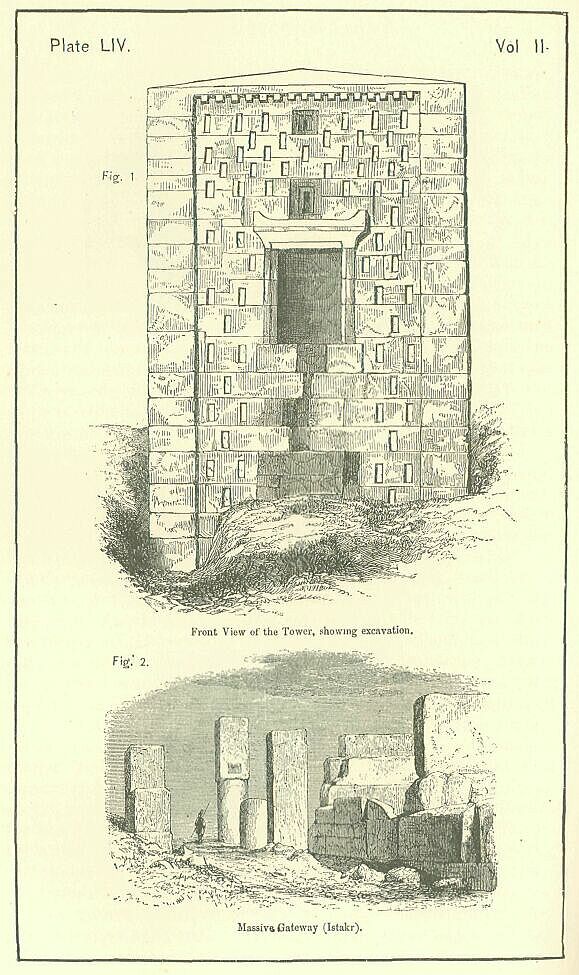
Another remarkable construction, which must belong to a very ancient period in the history of the country, is a gateway composed of enormous stones, which forms a portion of the ruins of Istakr. [PLATE LIV., Fig. 2.] It has generally been regarded as one of the old gates of the city; but its position in the gorge between the town wall and the opposite mountain, and the fact that it lies directly across the road from Pasargadae into the plain of Merdasht, seem rather to imply that it was one of those fortified "gates," which we know to have been maintained by the Persians, at narrow points along their great routes, for the purpose of securing them, and stopping the advance of an enemy. On either side were walls of vast thickness, on the one hand abutting upon the mountain, on the other probably connected with the wall of the town, while between them were three massive pillars, once, no doubt, the supports of a tower, from which the defenders of the gate would engage its assailants at a great advantage.
We have now described (so far as our data have rendered it possible) all the more important of the ancient edifices of the Persians, and may proceed to consider the next branch of the present inquiry, namely, their skill in the mimetic arts. Before, however, the subject of their architecture is wholly dismissed, a few words seem to be required on its general character and chief peculiarities.
First, then, the simplicity and regularity of the style are worthy of remark. In the ground-plans of buildings the straight line only is used; all the angles are right angles; all the pillars fall into line; the intervals between pillar and pillar are regular, and generally equal; doorways are commonly placed opposite intercolumniations; where there is but one doorway, it is in the middle of the wall which it pierces; where there are two, they correspond to one another. Correspondence is the general law. Not only does door correspond to door, and pillar to pillar, but room to room, window to window, and even niche to niche. Most of the buildings are so contrived that one half is the exact duplicate of the other; and where this is not the case, the irregularity is generally either slight, or the result of an alteration, made probably for convenience sake. Travellers are impressed with the Grecian character of what they behold, though there is an almost entire absence of Greek forms. The regularity is not confined to single buildings, but extends to the relations of different edifices one to another. The sides of buildings standing on one platform, at whatever distance they may be, are parallel. There is, however, less consideration paid than we should have expected to the exact position, with respect to a main building, in which a subordinate one shall be placed. Propylaea, for instance, are not opposite the centre of the edifice to which they conduct, but slightly on one side of the centre. And generally, excepting in the parallelism of their sides, buildings seem placed with but slight regard to neighboring ones.
For effect, the Persian architecture must have depended, firstly, upon the harmony that is produced by the observance of regularity and proportion; and, secondly, upon two main features of the style. These were the grand sculptured staircases which formed the approaches to all the principal buildings, and the vast groves of elegant pillars in and about the great halls. The lesser buildings were probably ugly, except in front. But such edifices as the Chehl Minar at Persepolis, and its duplicate at Susa—where long vistas of columns met the eye on every side, and the great central cluster was supported by lighter detached groups, combining similarity of form with some variety of ornament, where richly colored drapings contrasted with the cool gray stone of the building, and a golden roof overhung a pavement of many hues—must have been handsome, from whatever side they were contemplated, and for general richness and harmony of effect may have compared favorably with any edifices which, up to the time of their construction, had been erected in any country or by any people. If it may seem to some that they were wanting in grandeur, on account of their comparatively low height—a height which, including that of the platform, was probably in no case much more than a hundred feet—it must be remembered that the buildings of Greece and (except the Pyramids) those of Egypt, had the same defect, and that, until the constructive powers of the arch came to be understood, it was almost impossible to erect a building that should be at once lofty and elegant. Height, moreover, if the buildings are for use, implies inconvenience, a waste of time and power being involved in the ascent and descent of steps. The ancient architects, studying utility more than effect, preferred spreading out their buildings to piling them up, and rarely, unless in thickly-peopled towns, even introduced a second story.
The spectator, however, was impressed with a sense of grandeur in another way. The use of huge blocks of stone, not only in platforms, but in the buildings themselves, in the shafts of pillars, the antae of porticos, the jambs of doorways, occasionally in roofs, and perhaps in epistylia, produced the same impression of power, and the same feeling of personal insignificance in the beholder, which is commonly effected by great size in the edifice, and particularly by height. The mechanical skill required to transport and raise into place the largest of these blocks must have been very considerable, and their employment causes not merely a blind admiration of those who so built on the part of ignorant persons, but a profound respect for them on the part of those who are by their studies and tastes best qualified for pronouncing on the relative and absolute merits of architectural masterpieces.
Among the less pleasing peculiarities of the Persian architecture may be mentioned a general narrowness of doors in proportion to their height, a want of passages, a thickness of walls, which is architecturally clumsy, but which would have had certain advantages in such a climate, an inclination to place the doors of rooms near one corner, an allowance of two entrances into a great hall from under a single portico, a peculiar position of propylaea, and the very large employment of pillars in the interior of buildings. In many of these points, and also in the architectural use which was made of sculpture, the style of building resembled, to some extent, that of Assyria; the propylaea, however, were less Assyrian than Egyptian; while in the main and best features of the architecture, it was (so far as we can tell) original. The solid and handsome stone platforms, the noble staircases, and the profusion of light and elegant stone columns, which formed the true glory of the architecture—being the features on which its effect chiefly depended—have nowhere been discovered in Assyria; and all the evidence is against their existence. The Arians found in Mesopotamia an architecture of which the pillar was scarcely an element at all—which was fragile and unenduring—and which depended for its effect on a lavish display of partially colored sculpture and more richly tinted enamelled brick. Instead of imitating this, they elaborated for themselves, from the wooden buildings of their own mountain homes, a style almost exactly the reverse of that with which their victories had brought them into contact. Adopting, of main features, nothing but the platform, they imparted even to this a new character, by substituting in its construction the best for the worst of materials, and by further giving to these stone structures a massive solidity, from the employment of huge, blocks, which made them stand in the strongest possible contrast to the frail and perishable mounds of Babylonia and Assyria. Having secured in this way a firm and enduring basis, they proceeded to erect upon it buildings where the perpendicular line was primary and the horizontal secondary—buildings of almost, the same solid and massive character as the platform itself—forests of light but strong columns, supporting a wide-spreading roof, sometimes open to the air, sometimes enclosed by walls, according as they were designed for summer or winter use, or for greater or less privacy. To edifices of this character elaborate ornamentation was unnecessary; for the beauty of the column is such that nothing more is needed to set off a building. Sculpture would thus be dispensed with, or reserved for mere occasional use, and employed not so much on the palace itself as on its outer approaches; while brick enamelling could well be rejected altogether, as too poor and fragile a decoration for buildings of such strength and solidity.
The origination of this columnar architecture must be ascribed to the Medes, who, dwelling in or near the more wooden parts of the Zagros range, constructed, during the period of their empire, edifices of considerable magnificence, whereof wooden pillars were the principal feature, the courts being surrounded by colonnades, and the chief buildings having porticos, the pillars in both cases being of wood. A wooden roof rested on these supports, protected externally by plates of metal. We do not know if the pillars had capitals, or if they supported an entablature; but probability is in favor of both these arrangements having existed. When the Persians succeeded the Medes in the sovereignty of Western Asia, they found Arian architecture in this condition. As stone, however, was the natural material of their country, which is but scantily wooded and is particularly barren towards the edge of the great plateau, where their chief towns were situated, and as they had from the first a strong desire of fame and a love for the substantial and the enduring, they almost immediately substituted for the cedar and cypress pillars of the Medes, stone shafts, plain or fluted, which they carried to a surprising height, and fixed with such firmness that many of them have resisted the destructive powers of time, of earthquakes, and of vandalism for more than three-and-twenty centuries, and still stand erect and nearly as perfect as when they received the last touch from the sculptor's hand more than 2000 years ago. It is the glory of the Persians in art to have invented this style, which they certainly did not learn from the Assyrians, and which they can scarcely be supposed to have adopted from Egypt, where the conception of the pillar and its ornamentation were wholly different. We can scarcely doubt that Greece received from this quarter the impulse which led to the substitution of the light and elegant forms which distinguish the architecture of her best period from the rude and clumsy work of the more ancient times.
Of the mimetic art of the Persians we do not possess any great amount, or any great variety, of specimens. The existing remains consist of reliefs, either executed on the natural rock or on large slabs of hewn stone used in building, of impressions upon coins, and of a certain number of intaglios cut upon gems. We possess no Persian statues, no modelled figures, no metal castings, no carvings in ivory or in wood, no enamellings, no pottery even. The excavations on Persian sites have been singularly barren of those minor results which flowed so largely from the Mosopotamian excavations, and have yielded no traces of the furniture, domestic implements, or wall-ornamentation of the people; have produced, in fact, no small objects at all, excepting a few cylinders and some spear and arrow heads, thus throwing scarcely any light on the taste or artistic genius of the people.
The nearest approach to statuary which we meet with among the Persian remains are the figures of colossal bulls, set to guard portals, or porticos, which are not indeed sculptures in the round, but are specimens of exceedingly high relief, and which, being carved in front as well as along the side, do not fall very far short of statues. Of such figures, we find two varieties—one representing the real animal, the other a monster with the body and legs of a bull, the head of a man, and the wings of an eagle. There is considerable merit in both representations. They are free from the defect of flatness, or want of breadth in comparison with the length, which characterizes the similar figures of Assyrian artists; and they are altogether grand, massive, and imposing. The general proportions of the bulls are good, the limbs are accurately drawn, the muscular development is well portrayed, and the pose of the figure is majestic. Even the monstrous forms of human-headed bulls have a certain air of quiet dignity, which is not without its effect on the beholder; and, although implying no great artistic merit, since they are little more than reproductions of Assyrian models, indicate an appreciation of some of the best qualities of Assyrian art—the combination of repose with strength, of great size with the most careful finish, and of strangeness with the absence of any approach to grotesqueness or absurdity. The other Persian reliefs may be divided under four heads:
(1) Mythological representations of a man—the king apparently—engaged in combat with a lion, a bull, or a monster; (2) Processions of guards, courtiers, attendants, or tribute-bearers; (3) Representations of the monarch walking, seated upon his throne, or employed in the act of worship; and (4) Representations of lions and bulls, either singly or engaged in combat.
On the jambs of doorways in three of the Persepolitan buildings, a human figure, dressed in the Median robe, but with the sleeve thrown back from the right arm, is represented in the act of killing either a lion, a bull, or a grotesque monster. In every case the animal is rampant, and assails his antagonist with three of his feet, while he stands on the fourth. The lion and bull have nothing about them that is very peculiar; but the monsters present most strange and unusual combinations. One of them has the griffin head, which we have already seen in use in the capitals of columns, a feathered crest and neck, a bird's wings, a scorpion's tail, and legs terminating in the claws of an eagle. The other has an eagle's head, ears like an ass, feathers on the neck, the breast, and the back, with the body, legs, and tail of a lion. [PLATE LV., Fig. 1.] Figures of equal grotesqueness, some of which possess certain resemblances to these, are common in the mythology of Assyria, and have been already represented in these volumes; but the Persian specimens are no servile imitations of these earlier forms. The idea of the Assyrian artist has, indeed, been borrowed; but Persian fancy has worked it out in its own way, adding, modifying, and subtracting in such a manner as to give to the form produced a quite peculiar, and (so to speak) native character.
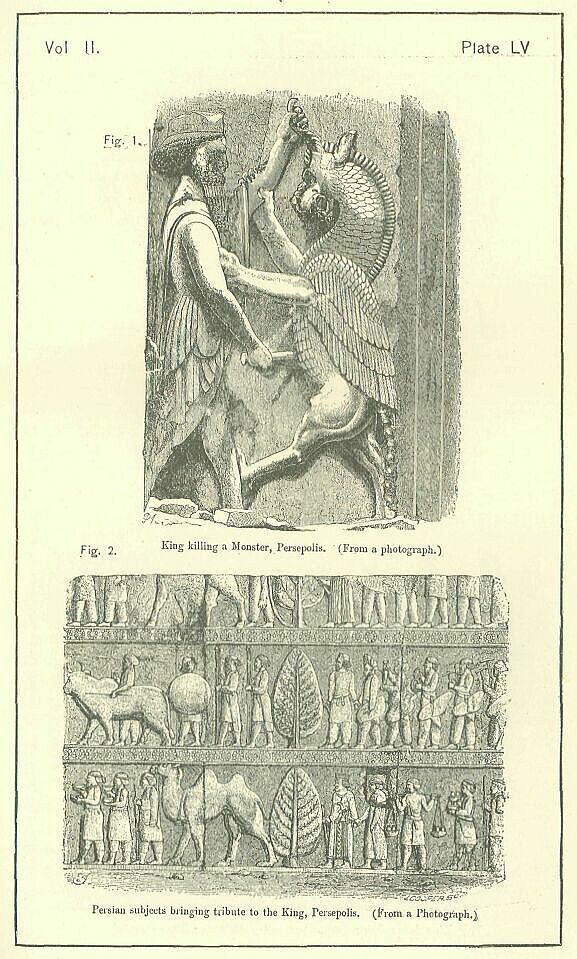
Persian gems abound with monstrous forms, of equal, or even superior grotesqueness. As the Gothic architects indulged their imagination in the most wonderful combinations to represent evil spirits or the varieties of vice and sensualism, so the Persian gem-engravers seem to have allowed their fancy to run riot in the creation of monsters, representative of the Powers of Darkness or of different kinds of evil, The stones exhibit the king in conflict with a vast variety of monsters, some nearly resembling the Persepolitan, while others have strange shapes unseen elsewhere. Winged lions, with two tails and with the horns of a ram or an antelope, sphinxes and griffins of half a dozen different kinds, and various other nondescript creatures, appear upon the Persian gems and cylinders, furnishing abundant evidence of the quaint and prolific fancy of the designers.
The processional subjects represented by the Persian artists are of three kinds. In the simplest and least interesting the royal guards, or the officers of the court, are represented in one or more lines of very similar figures, either moving in one direction, or standing in two bodies, one facing the other, in the attitude of quiet expectation. In these subjects there is a great sameness, and a very small amount of merit. The proportion of the forms is, indeed, fairly good, the heads and hands are well drawn, and there is some grace in certain of the figures, but the general effect is tame and somewhat heavy; the attitudes are stiff, and present little variety, while, nevertheless, they are sometimes impossible; there is a monotonous repetition of identically the same figure, which is tiresome, and a want of grouping which is very inartistic. If Persia had produced nothing better than this in sculpture, she would have had to be placed not only behind Assyria, but behind Egypt, as far as the sculptor's art is concerned.
Processional scenes of a more attractive character are, however, tolerably frequent. Some exhibit to us the royal purveyors arriving at the palace with their train of attendants, and bringing with them the provisions required for the table of the monarch. Here we have some varieties of costume which are curious, and some representations of Persian utensils, which are not without a certain interest. Occasionally, too, we are presented with animal forms, as kids, which have considerable merit.
But by far the most interesting of the processional scenes, are those which represent the conquered nations bringing to the monarch those precious products of their several countries which the Lord of Asia expected to receive annually, as a sort of free gift from his subjects, in addition to the fixed tribute which was exacted from them. Here we have a wonderful variety of costume and equipment, a happy admixture of animal with human forms, horses, asses, chariots, sheep, cattle, camels, interspersed among men, and the whole divided into groups by means of cypress-trees, which break the series into portions, and allow the eye to rest in succession upon a number of distinct pictures. Processions of this kind occurred on several of the Persepolitan staircases; but by far the most elaborate and complete is that on the grand steps in front of the Chehl Minar, or Great Hall of Audience, where we see above twenty such groups of figures, each with it own peculiar features, and all finished with the utmost care and delicacy. The illustration [PLATE LV., Fig. 2], which is taken from a photograph, will give a tolerable idea of the general character of this relief; it shows the greater portion of six groups, whereof two are much injured by the fall of the parapet-wall on which they were represented, while the remaining four are in good preservation. It will be noticed that the animal forms—the Bactrian camel and the humped ox—are superior to the human, and have considerable positive merit as works of art. This relative superiority is observable throughout the entire series, which contains, besides several horses (some of which have been already represented in these volumes), a lioness, an excellent figure of the wild ass, and two tolerably well-drawn sheep. [PLATE LVI., Fig. 2 and 3.]
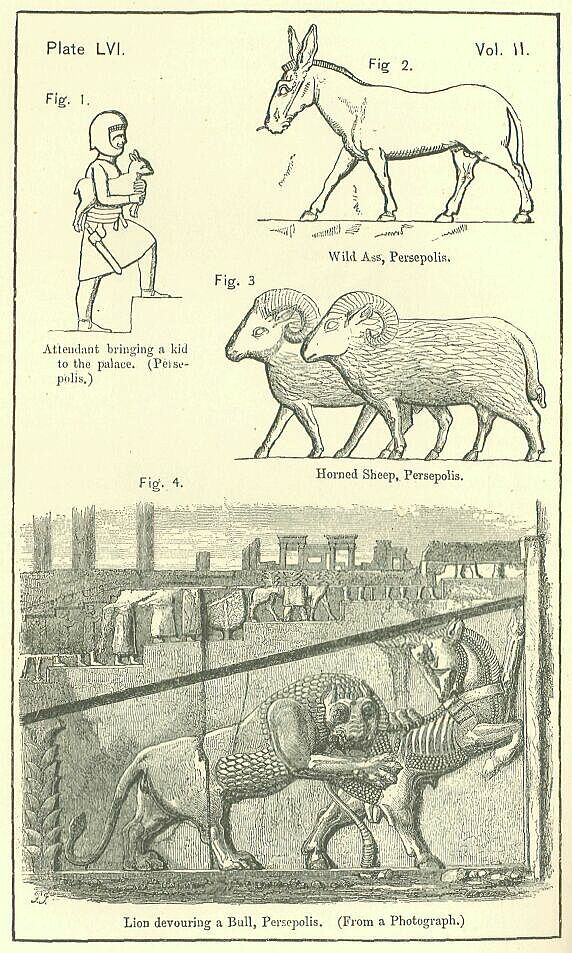
The representations of the monarch upon the reliefs are of three kinds. In the simplest, he is on foot, attended by the parasol-bearer and the napkin-bearer, or by the latter only, apparently in the act of proceeding from one part of the palace to another. In the more elaborate he is either seated on an elevated throne, which is generally supported by numerous caryatid figures, or he stands on a platform similarly upheld, in the act of worship before an altar. This latter is the universal representation upon tombs, while the throne scenes are reserved for palaces. In both representations the supporting figures are numerous; and it is here chiefly that we notice varieties of physiognomy, which are evidently intended to recall the differences in the physical type of the several races by which the Empire was inhabited. In one case, we have a negro very well portrayed; in others we trace the features of Scyths or Tatars. It is manifest that the artist has not been content to mark the nationality of the different figures by costume alone, but has aimed at reproducing upon the stone the physiognomic peculiarities of each race.
The purely animal representations which the bas-reliefs bring before us are few in number, and have little variety of type. The most curious and the most artistic is one which is several times repeated at Persepolis, where it forms the usual ornamentation of the triangular spaces on the facades of stairs. This is a representation of a combat between a lion and a bull, or (perhaps, we should rather say) a representation of a lion seizing and devouring a bull; for the latter animal is evidently powerless to offer any resistance to the fierce beast which has sprung upon him from behind, and has fixed both fangs and claws in his body. [PLATE LVI., Fig. 4.] In his agony the bull rears up his fore-parts, and turns his head feebly towards his assailant, whose strong limbs and jaws have too firm a hold to be dislodged by such struggles as his unhappy victim is capable of making. In no Assyrian drawing is the massiveness and strength of the king of beasts more powerfully rendered than in this favorite group, which the Persian sculptors repeated without the slightest change from generation to generation. The contour of the lion, his vast muscular development, and his fierce countenance are really admirable, and the bold presentation of the face in full, instead of in profile, is beyond the ordinary powers of Oriental artists.
Drawings of bulls and lions in rows, where each animal is the exact counterpart of all the others, are found upon the friezes of some of the tombs, and upon the representations of canopies over the royal throne. These drawings are fairly spirited, but have not any extraordinary merit. They reproduce forms well known in Assyria. A figure of a sitting lion seems also to have been introduced occasionally on the facades of staircases, occurring in the central compartment of the parapet-wall at top. These figures, in no case, remain complete; but enough is left to show distinctly what the attitude was, and this appears not to have resembled very closely any common Assyrian type. [PLATE LVII., Fig. 1.]
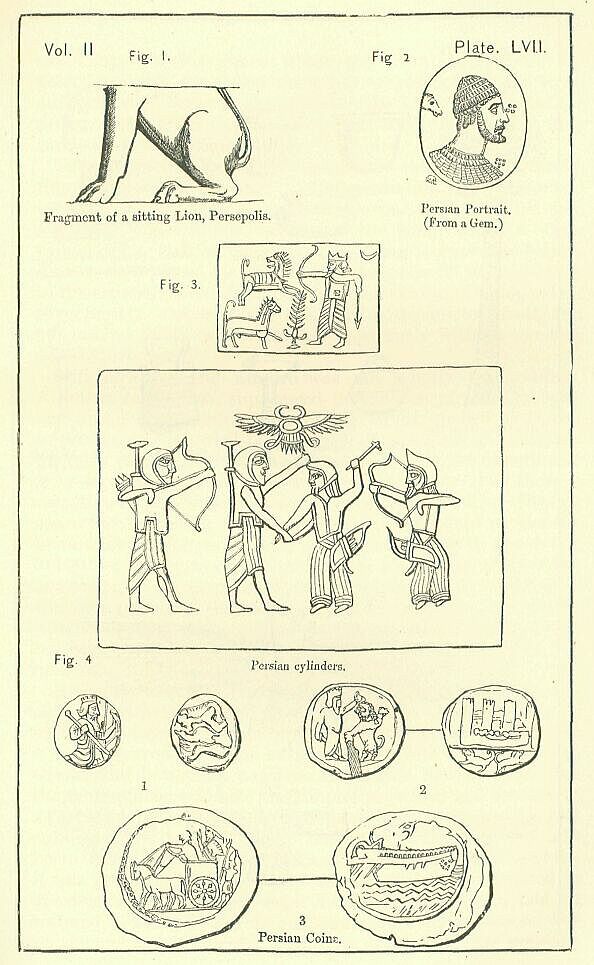
The Persian gem-engravings have considerable merit, and need not fear a comparison with those of any other Oriental nation. They occur upon hard stones of many different kinds, as cornelian, onyx, rock-crystal, sapphirine, sardonyx, chalcedony, etc., and are executed for the most part with great skill and delicacy. The designs which they embody are in general of a mythological character; but sometimes scenes of real life occur upon them, and then the drawing is often good, and almost always spirited. In proof of this, the reader may be referred to the hunting-scenes already given, which are derived wholly from this source, as well as to the gems figured [PLATE LVI., Fig. 3], one of which is certainly, and the other almost certainly, of Persian workmanship. In the former we see the king, not struggling with a mythological lion but engaged apparently in the actual chase of the king of beasts Two lions have been roused from their lairs, and the monarch hastily places an arrow on the string, anxious to despatch one of his foes before the other can come to close quarters The eagerness of the hunter and the spirit and boldness of the animals are well represented. In the other gem, while there is less of artistic excellence, we have a scene of peculiar interest placed before us. A combat between two Persians and two Cythians seems to be represented. The latter marked by their peaked cap and their loose trousers, fight with the bow and the battle-axe, the former with the bow and the sword One Scyth is receiving his death-wound, the other is about to let loose a shaft, but seems at the same time half inclined to fly The steady confidence of the warriors on the one side contrasts well with the timidity and hesitancy of their weaker and smaller rivals. [PLATE LVII., Fig. 3.]
The vegetable forms represented on the gems are sometimes graceful and pleasing. This is especially the case with palm-trees, a favorite subject of the artists, who delineated with remarkable success the feathery leaves, the pendant fruit and the rough bark of the stem. [PLATE LVIII., Fig 1.] The lion-hunter represented on the signet-cylinder of Darius Hystaspis takes place in a palm-grove, and furnishes the accompanying example of this form of vegetable life.
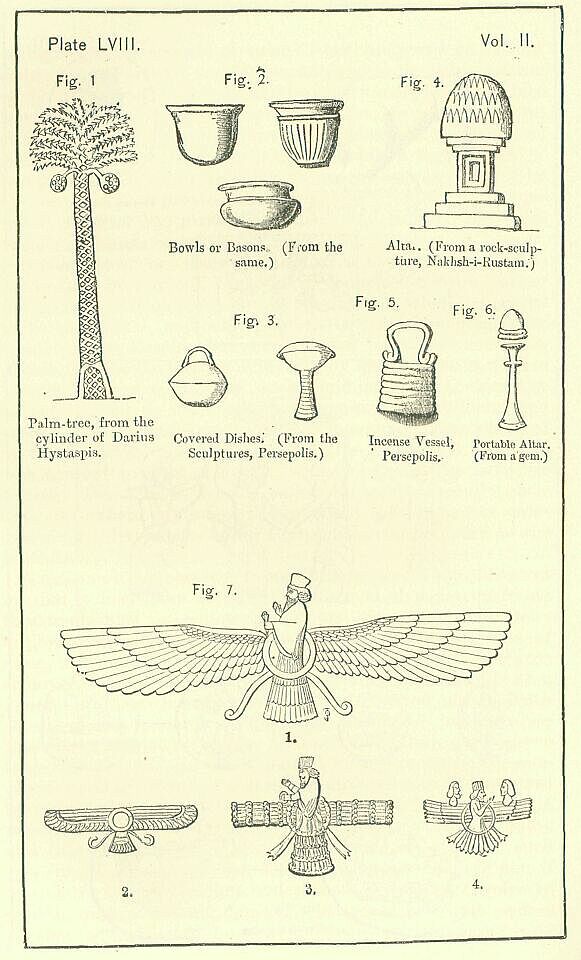
One gem, ascribed on somewhat doubtful grounds to the Persians of Achaemenian times, contains what appears to be a portrait. It is thought to be the bust of a satrap of Salamis in Cyprus, and is very carefully executed. If really of Persian workmanship, it would indicate a considerable advance in the power of representing the human countenance between the time of Darius Hystaspis and that of Alexander [PLATE LVII. Fig. 2.]
Persian coins are of three principal types. The earliest have on the one side the figure of a monarch bearing the diadem and armed with the bow and javelin, while on the other there is an irregular indentation of the same nature with the quadratum incusum of the Greeks. This rude form is replaced in later times by a second design, which is sometimes a horseman, sometimes the forepart of a ship, sometimes the king drawing an an arrow from his quiver. Another type exhibits on the obverse the monarch in combat with a lion while the reverse shows a galley, or a towered and battlemented city with two lions standing below it, back to back. The third common type has on the obverse the king in his chariot, with his charioteer in front of him, and (generally) an attendant carrying a fly-chaser behind. The reverse has either the trireme or the battlemented city. A specimen of each type is given. [PLATE LVII., Fig. 4.]
The artistic merit of these medals is not great. The relief is low, and the drawing generally somewhat rude. The head of the monarch in the early coins is greatly too large. The animal forms are, however, much superior to the human, and the horses which draw the royal chariot, the lions placed below the battlemented city, and the bulls which are found occasionally in the same position, must be pronounced truthful and spirited.
Of the Persian taste in furniture, utensils, personal ornaments and the like, we need say but little. The throne and footstool of the monarch are the only pieces of furniture represented in the sculptures, and these, though sufficiently elegant in their forms, are not very remarkable. Costliness of material seems to have been more prized than beauty of shape; and variety appears to have been carefully eschewed, one single uniform type of each article occurring in all the representations. The utensils represented are likewise few in number, and limited to certain constantly repeated forms. The most elaborate is the censer, which has been already given. With this is usually seen a sort of pail or basket, shaped like a lady's reticule, in which the aromatic gums for burning were probably kept. [PLATE LVIII., Fig. 5.] A covered dish, and a goblet with an inverted saucer over it, are also forms of frequent occurrence in the hands of the royal attendants; and the tribute-bearers frequently carry, among their other offerings, bowls or basons, which, though not of Persian manufacture, were no doubt left at the court, and took their place among the utensils of the palace. [PLATE LVIII., Figs. 2 and 3.]
In the matter of personal ornaments the taste of the Persians seems to have been peculiarly simple. Earrings were commonly plain rings of gold; bracelets mere bands of the same metal. Collars were circlets of gold twisted in a very inartificial fashion. There was nothing artistic in the sheaths or hilts of swords, though spear-shafts were sometimes adorned with the representation of an apple or a pomegranate. Dresses seem not to have been often patterned, but to have depended generally for their effect on make and color. In all these respects we observe a remarkable contrast between the Arian and the Semitic races, extreme simplicity characterizing the one, while the most elaborate ornamentation was affected by the other.
Persia was not celebrated in antiquity for the production of any special fabrics. The arts of weaving and dyeing were undoubtedly practised in the dominant country, as well as in most of the subject provinces, and the Persian dyes seem even to have had a certain reputation; but none of the productions of their looms acquired a name among foreign nations. Their skill, indeed, in the mechanical arts generally was, it is probable, not more than moderate. It was their boast that they were soldiers, and had won a position by their good swords which gave them the command of all that was most exquisite and admirable, whether in the natural world or among the products of human industry. So long as the carpets of Babylon and Sardis, the shawls of Kashmir and India, the fine linen of Borsippa and Egypt, the ornamental metal-work of Greece, the coverlets of Damascus, the muslins of Babylonia, the multiform manufactures of the Phoenician towns, poured continually into Persia Proper in the way of tribute, gifts, or merchandise, it was needless for the native population to engage largely in industrial enterprise.
To science the ancient Persians contributed absolutely nothing. The genius of the nation was adverse to that patient study and those laborious investigations from which alone scientific progress ensues. Too light and frivolous, too vivacious, too sensuous for such pursuits, they left them to the patient Babylonians, and the thoughtful, many-sided Greeks. The schools of Orchoe, Borsippa, and Miletus flourished under their sway, but without provoking their emulation, possibly without so much as attracting their attention. From first to last, from the dawn to the final close of their power, they abstained wholly from scientific studies. It would seem that they thought it enough to place before the world, as signs of their intellectual vigor, the fabric of their Empire and the buildings of Susa and Persepolis.
The original form of the Persian religion has been already described under the head of the third or Median monarchy. It was identical with the religion of the Medes in its early shape, consisting mainly in the worship of Ahura-Mazda, the acknowledgment of a principle of evil—Angro-Mainyus, and obedience to the precepts of Zoroaster. When the Medes, on establishing a wide-spread Empire, chiefly over races by whom Magism had been long professed, allowed the creed of their subjects to corrupt their own belief, accepted the Magi for their priests, and formed the mixed religious system of which an account has been given in the second volume of this work, the Persians in their wilder country, less exposed to corrupting influences, maintained their original faith in undiminished purity, and continued faithful to their primitive traditions. The political dependence of their country upon Media during the period of the Median sway made no difference in this respect; for the Medes were tolerant, and did not seek to interfere with the creed of their subjects. The simple Zoroastrian belief and worship, overlaid by Magism in the now luxurious Media, found a refuge in the rugged Persian uplands, among the hardy shepherds and cultivators of that unattractive region, was professed by the early Achaemenian princes, and generally acquiesced in by the people.
The main feature of the religion daring this first period was the acknowledgment and the worship of a single supreme God—"the Lord God of Heaven"—"the giver (i.e. maker) of heaven and earth"—the disposer of thrones, the dispenser of happiness. The foremost place in inscriptions and decrees was assigned, almost universally, to the "great god, Ormazd." Every king, of whom we have an inscription more than two lines in length, speaks of Ormazd as his upholder; and the early monarchs mention by name no other god. All rule "by the grace of Ormazd." From Ormazd come victory, conquest, safety, prosperity, blessings of every kind. The "law of Ormazd" is the rule of life. The protection of Ormazd is the one priceless blessing for which prayer is perpetually offered.
While, however, Ormazd holds this exalted and unapproachable position, there is still an acknowledgment made, in a general way, of "other gods." Ormazd is "the greatest of the gods" (mathista baganam). It is a usual prayer to ask for the protection of Ormazd, together with that of these lesser powers (hada bagaibish). Sometimes the phrase is varied, and the petition is for the special protection of a certain class of Deities—the Dii familiares—or "deities who guard the house."
The worship of Mithra, or the Sun, does not appear in the inscriptions until the reign of Artaxerxes Mnemon, the victor of Cunaxa. It is, however, impossible to doubt that it was a portion of the Persian religion, at least as early as the date of Herodotus. Probably it belongs, in a certain sense, to primitive Zoroastrianism, but was kept in the background during the early period, when a less materialistic worship prevailed than suited the temper of later times.
Nor can it be doubted that the Persians held during this early period that Dualistic belief which has been the distinguishing feature of Zoroastrianism from a time long anterior to the commencement of the Median Empire down to the present day. It was not to be expected that this belief would show itself in the inscriptions, unless in the faintest manner; and it can therefore excite no surprise that they are silent, or all but silent, on the point in question. Nor need we wonder that this portion of their creed was not divulged by the Persians to Herodotus or to Xenophon, since it is exactly the sort of subject on which reticence was natural and might have been anticipated. Neither the lively Halicarnassian, nor the pleasant but somewhat shallow Athenian, had the gift of penetrating very deeply into the inner mind of a foreign people; added to which, it is to be remembered that they were unacquainted with Persia Proper, and drew their knowledge of Persian opinions and customs either from hearsay or from the creed and practices of the probably mixed garrisons which held Asia Minor, Syria, and Egypt.
Persian worship, in these early times, was doubtless that enjoined by the Zendavesta, comprising prayer and thanksgiving to Ormazd and the good spirits of his creation, the recitation of Gathas or hymns, the performance of sacrifice, and participation in the Soma ceremony. Worship seems to have taken place in temples, which are mentioned (according to the belief of most cuneiform scholars) in the Behistun inscription. Of the character of these buildings we can say nothing. It has been thought that those two massive square towers so similar in construction, which exist in a more or less ruined condition at Murgab and Nakhsh-i-Rustam, are Persian temples of the early period, built to contain an altar on which the priests offered victims. But the absence of any trace of an altar from both, the total want of religious emblems, and the extremely small size of the single apartment which each tower contains, make strongly against the temple theory; not to mention that a much more probable use may be suggested for the buildings.
With respect to the altars upon which sacrifice was offered, we are not left wholly without evidence. The Persian monarchs of the early period, including Darius Hystaspis, represented themselves on their tombs in the act of worship. Before them, at the distance of a few feet, stands an altar, elevated on three steps, and crowned with the sacrificial fire. Its form is square, and its only ornaments are a sunken squared recess, and a strongly projecting cornice at top. The height of the altar, including the steps, was apparently about four and a half feet. [PLATE LVIII., Fig. 4.]
The Persians' favorite victim was the horse; but they likewise sacrificed cattle, sheep, and goats. Human sacrifices seem to have been almost, if not altogether, unknown to them, and were certainly alien to the entire spirit of the Zoroastrian system. The flesh of the victim was probably merely shown to the sacred fire, after which it was eaten by the priests, the sacrificer, and those whom the latter associated with himself in the ceremony.
The spirit of the Zendavesta is wholly averse to idolatry, and we may fully accept the statement of Herodotus that images of the gods were entirely unknown to the Persians. Still, they did not deny themselves a certain use of symbolic representations of their deities, nor did they even scruple to adopt from idolatrous nations the forms of their religious symbolism. The winged circle, with or without the addition of a human figure, which was in Assyria the emblem of the chief Assyrian deity, Asshur, became with the Persians the ordinary representation of the Supreme God, Ormazd, and, as such, was placed in most conspicuous positions on their rock tombs and on their buildings. [PLATE LVIII., Fig. 7.] Nor was the general idea only of the emblem adopted, but all the details of the Assyrian model were followed, with one exception. The human figure of the Assyrian original wore the close-fitting tunic, with short sleeves, which was the ordinary costume in Assyria, and had on its head the horned cap which marked a god or a genius. In the Persian counterpart this costume was exchanged for the Median robe, and a tiara, which was sometimes that proper to the king,23 sometimes that worn with the Median robe by court officers. [PLATE LVIII., Fig. 7.]
Mithra, or the Sun, is represented in Persian sculptures by a disk or orb, which is not four-rayed like the Assyrian, but perfectly plain and simple. In sculptures where the emblems of Ormazd and Mithra occur together, the position of the former is central, that of the latter towards the right hand of the tablet. The solar emblem is universal on sculptured tombs, but is otherwise of rare occurrence.
Spirits of good and evil, the Ahuras and Devas of the mythology, were represented by the Persians under human, animal, or monstrous forms. There can be little doubt that it is a good genius—perhaps the "well-formed, swift, tall Serosh"—who appears on one of the square pillars set up by Cyrus at Pasargadae. This figure is that of a colossal man, from whose shoulders issue four wings, two of which spread upwards above his head, while the other two droop and reach nearly to his feet. [PLATE LIX.] It stands erect, in profile, with both arms raised and the hands open. The costume of the figure is remarkable. It consists of a long fringed robe reaching from the neck to the ankles—apparently of a stiff material, which conceals the form—and of a very singular head-dress. This is a striped cap, closely fitting the head, overshadowed by an elaborate ornament, of a character purely Egyptian. First there rise from the top of the cap two twisted horns, which, spreading right and left, become a sort of basis for the other forms to rest upon. These consist of two grotesque human-headed figures, one at either side, and of a complex triple ornament between them, clumsily imitated from a far more elegant Egyptian model. [PLATE LX., Fig. 1.]
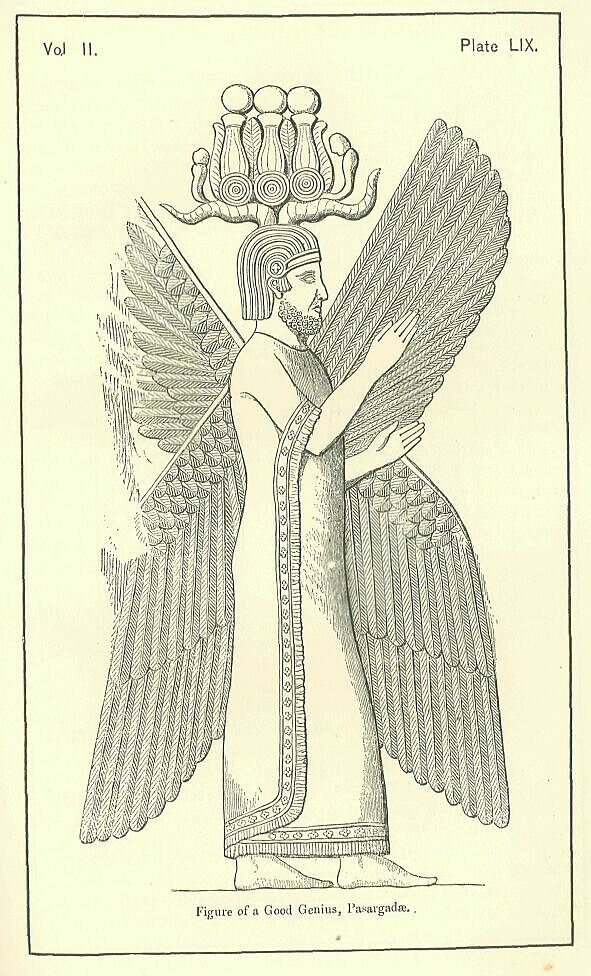
The winged human-headed bulls, which the Persians adopted from the Assyrians, with very slight modifications, were also, it is probable, regarded as emblems of some god or good genius. They would scarcely otherwise have been represented on Persian cylinders as upholding the emblem of Ormazd in the same way that human-headed bulls uphold the similar emblem of Asshur on Assyrian cylinders. [PLATE LX., Fig. 2.] Their position, too, at Persepolis, where they kept watch over the entrance to the palace, accords with the notion that they represented guardian spirits, objects of the favorable regard of the Persians. Yet this view is not wholly free from difficulty. The bull appears in the bas-reliefs of Persepolis among the evil, or at any rate hostile, powers, which the king combats and slays; and though in these representations the animal is not winged or human-headed, yet on some cylinders apparently Persian, the monarch contends with bulls of exactly the same type as that which is assigned in other cylinders to the upholders of Ormazd. It would seem therefore that in this case the symbolism was less simple than usual, the bull in certain combinations and positions representing a god or a good spirit, while in others he was the type of a deva or evil genius.
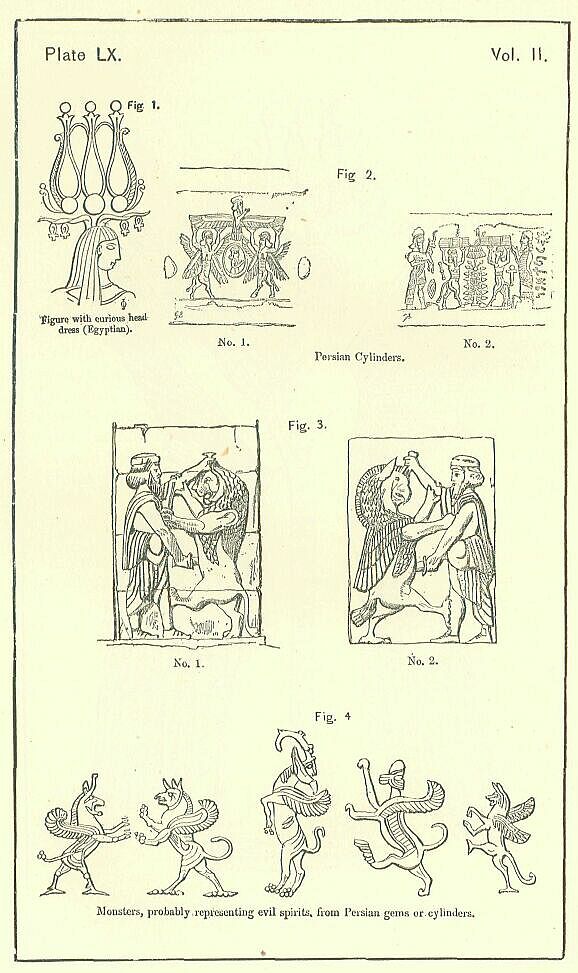
The most common representatives of the Evil Powers of the mythology were lions, winged or unwinged, and monsters of several different descriptions. At Persepolis the lions which the king stabs or strangles are of the natural shape, and this type is found also upon gems and cylinders; but on these last the king's antagonist is often a winged, while sometimes he is a winged and horned, lion. [PLATE LX., Fig. 3.] The monsters are of two principal types. In both the forms of a bird and a beast are commingled; but in the one the bird, and in the other the beast predominates. Specimens are given [PLATE LX., Fig. 4] taken from Persian gems and cylinders.
Such seems to have been, in outline, the purer and more ancient form of the Persian religion. During its continuance a fierce iconoclastic spirit animated the princes of the Empire, who took every opportunity of showing their hatred and contempt for the idolatries of the neighboring nations, burning temples, confiscating or destroying images, scourging or slaying idolatrous priests, putting a stop to festivals, disturbing tombs, smiting with the sword animals believed to be divine incarnations. Within their own dominions the fear of stirring up religious wars compelled them to be moderately tolerant, unless it were after rebellion, when a province lay at their mercy; but when they invaded foreign countries, they were wont to exhibit in the most open and striking way their aversion to materialistic religions. In Greece, during the great invasion, they burned every temple that they came near; in Egypt, on their first attack, they outraged every religious feeling of the people.
It was during this time of comparative purity, when the anti-idolatrous spirit was in full force, that a religious sympathy seems to have drawn together the two nations of the Persians and the Jews. Cyrus evidently identified Jehovah with Ormazd, and, accepting as a divine command the prophecy of Isaiah, undertook to rebuild their temple for a people who, like his own, allowed no image of God to defile the sanctuary. Darius, similarly, encouraged the completion of the work, after it had been interrupted by the troubles which followed the death of Cambyses. The foundation was thus laid for that friendly intimacy between the two peoples, of which we have abundant evidence in the books of Ezra, Nehemiah, and Esther, a friendly intimacy which caused the Jews to continue faithful to Persia to the last, and to brave the conqueror of Issus rather than desert masters who had shown them kindness and sympathy.
The first trace that we have of a corrupting influence being brought to bear on the Persian religion is connected with the history of the pseudo-Smerdis. According to Herodotus, Cambyses, when he set out on his Egyptian expedition, left a Magus, Patizeithes, at the capital, as comptroller of the royal household. The conferring of an office of such importance on the priest of an alien religion is the earliest indication which we have of a diminution of zeal for their ancestral creed on the part of the Achaemenian kings, and the earliest historical proof of the existence of Magism beyond the limits of Media. Magism was really, it is probable, an older creed than Zoroastrianism in the country where the Persians were settled; but it now, for the first time since the Persian conquest, began to show itself, to thrust itself into high places, and to attract general notice. From being the religion of the old Scythic tribes whom the Persians had conquered and whom they held in subjection, it had passed into being the religion of great numbers of the Persians themselves. The same causes which had corrupted Zoroastrianism in Media soon after the establishment of the Empire, worked also, though more slowly, in Persia, and a large section of the nation was probably weaned from its own belief, and won over to Magism, before Cambyses went into Egypt. His prolonged absence in that country brought matters to a crisis. The Magi took advantage of it to attempt a substitution of Magism for Zoroastrianism as the religion of the state. When this attempt failed, there was no doubt a reaction for a time, and Zoroastrianism thought itself triumphant. But a foe is generally most dangerous when he is despised. Magism, repulsed in its attempt to oust the rival religion, derived wisdom from the lesson, and thenceforth set itself to sap the fortress which it could not storm. Little by little it crept into favor, mingling itself with the old Arian creed, not displacing it, but only adding to it. In the later Persian system the Dualism of Zoroaster and the Magian elemental worship were jointly professed—the Magi were accepted as the national priests—the rights and ceremonies of the two religions were united—a syncretism not unusual in the ancient world blended into one two creeds originally quite separate and distinct, but in few respects antagonistic—and the name of Zoroaster being still fondly cherished in the memory of the nation, while in their practical religion Magian rites predominated, the mixed religion acquired the name, by which it was known to the later Greeks, of "the Magism of Zoroaster."
The Magian rites have been described in the chapter on the Median Religion. Their leading feature was the fire-worship, which is still cherished among those descendants of the ancient Persians who did not submit to the religion of Islam. On lofty spots in the high mountain-chain which traversed both Media and Persia, fire-altars were erected, on which burnt a perpetual flame, watched constantly lest it should expire, and believed to have been kindled from heaven. Over the altar in most instances a shrine or temple was built; and on these spots day after day the Magi chanted their incantations, displayed their barsoms or divining-rods, and performed their choicest ceremonies. Victims were not offered on these fire-altars. When a sacrifice took place, a fire was laid hard-by with logs of dry wood, stript of their bark, and this was lighted from the flame which burned on the altar. On the fire thus kindled was consumed a small part of the fat of the victim; but the rest was cut into joints, boiled, and eaten or sold by the worshipper. The true offering, which the god accepted, was, according to the Magi, the soul of the animal.
If human victims were ever really offered by the Persians as sacrifices, it is to Magian influence that the introduction of this horrid practice must be attributed, since it is utterly opposed to the whole spirit of Zoroaster's teaching. An instance of the practice is first reported in the reign of Xerxes, when Magism, which had been sternly repressed by Darius Hystaspis, began once more to lift its head, crept into favor at Court, and obtained a status which it never afterwards forfeited. According to Herodotus, the Persians, on their march into Greece, sacrificed, at Ennea Hodoi on the Strymon river, nine youths and nine maidens of the country, by burying them alive. Herodotus seems to have viewed the act as done in propitiation of a god resembling the Grecian Pluto; but it is not at all certain that he interpreted it correctly. Possibly he mistook a vengeance for a religious ceremony. The Brygi, who dwelt at this time in the vicinity of Ennea Hodoi, had given Mardonius a severe defeat on a former occasion; and the Persians were apt to treasure up such wrongs, and visit them, when occasion offered, with extreme severity.
When the Persians had once yielded to the syncretic spirit so far as to unite the Magian tenets and practices with their primitive belief, they were naturally led on to adopt into their system such portions of the other religions, with which they were brought into close contact, as possessed an attraction for them. Before the date of Herodotus they had borrowed from the Babylonians the worship of a Nature-Goddess, whom the Greeks identified at one time with Aphrodite, at another with Artemis, at another (probably) with Here, and had thus made a compromise with one of the grossest of the idolatries which, theoretically, they despised and detested. The Babylonian Venus, called in the original dialect of her native country Nana, was taken into the Pantheon of the Persians, under the name of Nansea, Anaea, Anaitis, or Tanata, and became in a little while one of the principal objects of Persian worship. At first idolatry, in the literal sense, was avoided; but Artaxerxes Mnemon, the conqueror of Cunaxa, an ardent devotee of the goddess, not content with the mutilated worship which he found established, resolved to show his zeal by introducing into all the chief cities of the Empire the image of his patroness. At Susa, at Persepolis, at Babylon, at Ecbatana, at Damascus, at Sardis, at Bactra, images of Anaitis were set up by his authority for the adoration of worshippers. It is to be feared that at this time, if not before, the lascivious rites were also adopted, which throughout the East constituted the chief attraction of the cult of Venus.
With the idolatry thus introduced, another came soon to be joined. Mithra, so long an object of reverence, if not of actual worship, to the Zoroastrians, was in the reign of Artaxerxes Mnemon, honored, like Anaitis, with a statue, and advanced into the foremost rank of deities. The exact form which the image took is uncertain; but probability is in favor of the well-known type of a human figure slaying a prostrate bull, which was to the Greeks and Romans the essential symbol of the Mithraic worship. The intention of this oft-repeated group has been well explained by Hyde, who regards it as a representation of the Sun quitting the constellation of Taurus, the time when in the East his fructifying power is the greatest. The specimens which we possess of this group belong to classical art and to times later than Alexander; but we can scarcely suppose the idea to have been Occidental. The Western artists would naturally adopt the symbolism of those from whom they took the rites, merely modifying its expression in accordance with their own aesthetic notions.
Towards the close of the Empire two other gods emerged from the obscurity in which the lower deities of the Zoroastrian system were shrouded during the earlier and purer period. Vohu-manu, or Bah-man, and Amerdat, or Amendat, two of the councillors of Ormazd, became the objects of a worship, which was clearly of an idolatrous character. Shrines were built in their honor, and were frequented by companies of Magi, who chanted their incantations, and performed their rites of divination in these new edifices as willingly as in the old Fire-temples. The image of Bah-man was of wood, and was borne in procession on certain occasions.
Thus as time went on, the Persian religion continually assimilated itself more and more to the forms of belief and worship which prevailed in the neighboring parts of Asia. Idolatries of several kinds came into vogue, some adopted from abroad, others developed out of their own system. Temples, some of which had a character of extraordinary magnificence, were erected to the honor of various gods; and the degenerate descendants of pure Zoroastrian spiritualists bowed down to images, and entangled themselves in the meshes of a sensualistic and most debasing Nature-worship. Still, amid whatsoever corruptions, the Dualistic faith was maintained. The supremacy of Ormazd was from first to last admitted. Ahriman retained from first to last the same character and position, neither rising into an object of worship, nor sinking into a mere personification of evil. The inquiries which Aristotle caused to be made, towards the very close of the Empire, into the true nature of the Persian Religion, showed him Ormazd and Ahriman still recognized as Principles, still standing in the same hostile and antithetical attitude, one towards the other, which they occupied when the first Fargard of the Vendidad was written, long anterior to the rise of the Persian Power.